
Fuggedaboutit....Angelo Bruno's assassination was hands down the start of the biggest gangster war in the city of brotherly love. From 1980 to 1985 over 20 hits took place. Not a week went by without a gangster story in all the major city papers. Speakeasies, loan sharking, numbers racket, flimflams, scams, back room card games, burglaries, bootlegging, extortion, murder, prostitution and of course illegal drugs turned the gears that bred gangsters. Philadelphia gangsters like any other major american city are as old as muskets and sailing ships. Irish, Jews, Italians, Blacks and every other ethnic group who landed on the shores of the free world had their turn at breeding gangsters, and the tradition continues. This web-site is and always will be a work in progress, as I am finding new things out about the past, and of course Philly will always have gangsters, just not always in three button suits. As information continues, updates and new information will be posted. Any info and contributions are very welcome. The information here was gleaned from news papers, police reports, books and other places of similar interest. The author makes no claim of any of this to be fact. [email protected]
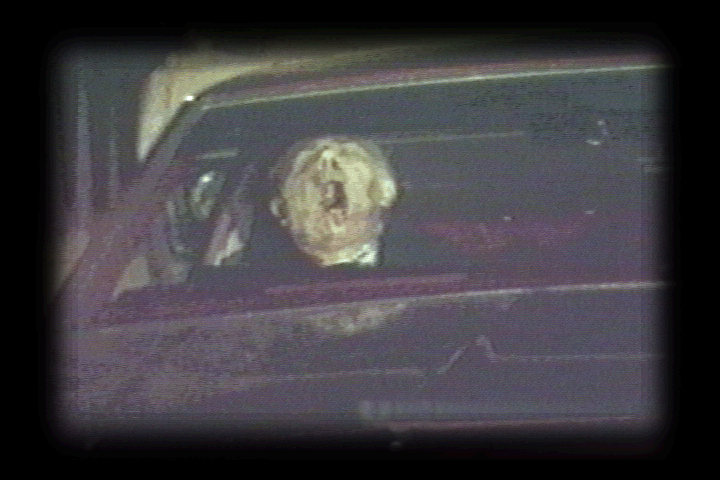
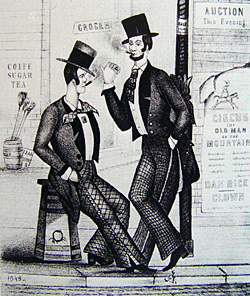 The Killers (left) were among the first of a group of Philly gangsters strictly born of ethnicity. Scott and English Activist gangs during the 17th century, organized themselves under the cover of Volunteer Firemen. Historians have identified 50 such violent Philadelphia street gangs during the era with such colorful names as the Blood Tubs, the Schuylkill Rangers, the Neckers and the Snappers. The gangs fought each other and often attacked innocent citizens on the streets.In the summer of 1844 nativist gangs roamed the streets of Philadelphia and it's then surrounding Burroughs Kensington not yet consolidated into the city looking to destroy everything they could having to do with the Irish. To the shame of the entire young country, they did the unthinkable, They burnt Saint Michael's Catholic church to the ground. Newspapers throughout the world reported the burning. The City of Brotherly love received a black eye that took decades to recover from. Other churches were also the the victim of Irish hate. Jews, Blacks and anyone else who didn't have English Scott blood running through their vain's were not Americans, and unwelcome. American Indians were even worse off. They were being driven out of the future land of the free to reservations. But soon other ethnic groups would arrive and organize into an underworld of secret societies, as in the secret society of the Irish Molly Maguire's. The Molly Maguire's was an Irish 19th century secret society active in Ireland, Liverpool and parts of the eastern United States, best known for their activism among Irish American and Irish immigrant coal miners in Pennsylvania. After a series of often violent conflicts, twenty suspected members of the Molly Maguire's were convicted of murder and other crimes and were executed by hanging in 1877 and 1878. They having the longest history in organized crime and the world of gangsters held strong in their tenacious clannish ways.
The Killers (left) were among the first of a group of Philly gangsters strictly born of ethnicity. Scott and English Activist gangs during the 17th century, organized themselves under the cover of Volunteer Firemen. Historians have identified 50 such violent Philadelphia street gangs during the era with such colorful names as the Blood Tubs, the Schuylkill Rangers, the Neckers and the Snappers. The gangs fought each other and often attacked innocent citizens on the streets.In the summer of 1844 nativist gangs roamed the streets of Philadelphia and it's then surrounding Burroughs Kensington not yet consolidated into the city looking to destroy everything they could having to do with the Irish. To the shame of the entire young country, they did the unthinkable, They burnt Saint Michael's Catholic church to the ground. Newspapers throughout the world reported the burning. The City of Brotherly love received a black eye that took decades to recover from. Other churches were also the the victim of Irish hate. Jews, Blacks and anyone else who didn't have English Scott blood running through their vain's were not Americans, and unwelcome. American Indians were even worse off. They were being driven out of the future land of the free to reservations. But soon other ethnic groups would arrive and organize into an underworld of secret societies, as in the secret society of the Irish Molly Maguire's. The Molly Maguire's was an Irish 19th century secret society active in Ireland, Liverpool and parts of the eastern United States, best known for their activism among Irish American and Irish immigrant coal miners in Pennsylvania. After a series of often violent conflicts, twenty suspected members of the Molly Maguire's were convicted of murder and other crimes and were executed by hanging in 1877 and 1878. They having the longest history in organized crime and the world of gangsters held strong in their tenacious clannish ways.
The prominent Irish street gang pre-twentieth century were the Schuylkill Rangers, headed by gangster Jimmy Haggerty, whose boyhood home was located on Arch Street in the area between Eighteenth and Nineteenth Street known as "McAran's Garden".
After numerous arrests for theft and similar offenses, Haggerty and Schuylkill Ranger Hugh Murphy were convicted of the robbery of a Ninth Street store and sentenced to ten years imprisonment on December 12, 1865. He was pardoned by Governor Andrew G. Curtin eight months later, in part to Haggerty's political connections and his promise to leave the country upon his release, and lived in Canada for a brief time before returning to the city to resume his criminal career. Haggerty remained a major underworld figure in Philadelphia until January 1869 when he was arrested on several counts of assault with intent to kill; during his arrest, he shot the arresting police officer.He was caught trying to escape from prison but was later released on bail and fled the city. Staying in New York for a brief time, he returned to Philadelphia in April to surrender himself to authorities after the wounded police officer had received "hush money". He won both court cases against him, but was ordered at the second trial to return to the by the District Attorney for violating the terms of his release. While his lawyers argued the ruling, Haggerty escaped from the courthouse during a recess in what was suspected to have been planned.
The Nativists moved on in the American mainstream and put their hate of the new coming Irish behind them. Other groups were starting to arrive at the turn of the century, as Italians and Jews were next to be hated.
More on the Mid 1800s Gangs By Ken Finkel
“Armed to the teeth” with “pocket pistols, knives, or those horrible inventions known as ‘slung-shot,'” Philadelphia’s gangs dominated the streets of Southwark and Moyamensing in the 1840s, raining bricks and reigning terror.
How had it gotten so out of control? The lack of police beyond the city’s southern border – then South Street. And the give-and-take of street warfare. The cycle of violence begins when a gang member “escapes barely with his life, and mangled, wounded, and bleeding, makes his appearance among his confederates and companions, details a vivid account of the manner in which he was assailed… A spirit of vengeance is kindled… threats of retaliation are uttered, and an early opportunity is sought, to pay back in the same coin, with bricks, bludgeons and knives, the attack upon their brother. When the fight is once commenced under these circumstances, the feelings become inflamed, the mind is maddened, the blood heated, and the scene is often of the most fearful character. This, we believe, is the whole story with regard to most of the collisions which have recently taken place.”
“What is the remedy?” asked the Inquirer in desperation during the the hot summer of 1849.
Meanwhile, all hell had broken loose. “We are told there are no less than five gangs of organized ruffians, either in the county, or on the outskirts of the city.” Seasoned columnist George Foster identified eleven “squads or clubs” in Southwark and Moyamensing populated by “loafers” who give themselves “outlandish titles.” The fiercer the better. Marauding the streets were Killers, Bouncers, Rats, Stingers, Nighthawks, Buffers, Skinners, Gumballs, Smashers, Whelps, Flayers “and other appropriate and verminous designations.” They marked their territories by fighting, rioting, and writing “in chalk or charcoal on every dead-wall, fence and stable-door.” They held their “nightly conclaves on the corners of by-streets or in unoccupied building-lots, sneaking about behind the rubbish-heaps, and perhaps now and then venturing out to assault an unprotected female or knock down a lonely passenger.”
And worse. On Election Day, 1849, the Killers and the Stingers corralled a few hundred of their allies and attacked the California House at Sixth and St. Mary Street (now Naudain), a tavern operated by an interracial couple. The battle “raged for a night and a day” before causalities were counted . “Dreadful Riot,” read one of several headlines,” Houses Burned, and Several Persons Killed and Wounded.”
For years, the newspapers had been crying out for “the law efficiently and vigorously administered” no matter what the cost. “Is it not possible for the authorities of the immediate districts concerned, to secure one or two of the ringleaders?” they demanded. “Are the citizens of that district content to live in such a state of anarchy?”
Apparently, the citizens had little choice in the matter. According to David R. Johnson in The Peoples of Philadelphia, The Public Ledger reported on the doings of no less than 51 gangs. In an effort to be even more comprehensive—from sources listed below as well as the Inquirer—we located an additional 14.
Here are the gangs, the Philadelphia 65, listed in alphabetical order:
American Guards; Bleeders; Blood Tubs; Blossoms; Bouncers; Buffers; Bugs; Bulldogs; Centre Street Boys; Chesapeakes; Crockets; Darts; Deathfetchers; Dogs; Dog-Towners; Flayers; Fly-By-Nights; Garroters; Gumballs; Hyenas; Jack of Clubs; Jumpers; Juniatta Club; Kensington Blackhawks; Kerryonians; Keystone No. 2; Killers; Lancers; Molly Maguires; Neckers; Nighthawks; Orangemen; Pickwick Club; Pluckers; Pots No. 2; Privateer Club No. 1; Rangers; Rats; Reading Hose Club; Rebels; Red Roses; Reed Birds; Schuylkill Rangers; Shifflers; Skinners; Smashers; Snakers; Snappers; Spiggots; Spitfires; Sporters; Springers; Stingers; Stockholders; The Forty Thieves; The Vesper Social; Tormentors; Turks; Vampyres; Waynetowners; Weecys; Whelps; Wild Cats; Wreckers.
If these boys and men had heroes, these were the toughest of Philadelphia’s volunteer firemen who, according to Bruce Laurie, they “gazed upon and followed in awe and reverence.” But unlike the gangs, which more often than not served as firefighting farm teams, the city’s volunteer fire companies chose names without bite, or even growl. Fact was, the fire companies found resonance in their choices of civic-sounding names: Assistance, Diligent, Friendship, Good Intent, Good Will, Hand-In-Hand, Harmony, Hope, Humane, Perseverance, Reliance and Vigilant.
The Tongs
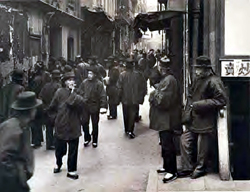 The Tongs originated as Chinese Benevolent Associations on the west coast of the United States during the Gold Rush era. Although believed to be offshoots of the Triads, they were formed primarily as a means of protection from white racists who periodically raided "Chinatown" areas. Anti-Chinese riots were common in the late 1800's, especially in San Francisco and New York City. It was not unusual, for instance, for groups of Chinese to be murdered while local authorities remained indifferent.
The Tongs originated as Chinese Benevolent Associations on the west coast of the United States during the Gold Rush era. Although believed to be offshoots of the Triads, they were formed primarily as a means of protection from white racists who periodically raided "Chinatown" areas. Anti-Chinese riots were common in the late 1800's, especially in San Francisco and New York City. It was not unusual, for instance, for groups of Chinese to be murdered while local authorities remained indifferent.
The Tongs exist openly and are based chiefly on business affiliations. Many Triad members emigrating from China joined the Tongs when they arrived in the United States. This is not to say that the five or six Tong organizations that are active today are criminally controlled, but in many cities Tong chapters are certainly influenced by members of Triad groups.
Three of the major Tongs, the Hip Sing Tong, the Tung On Association, and the On Leong Merchants Association, are headquartered in New York City and maintain branches in Philadelphia. These Tongs are involved in illegal gambling activities. As in most Tongs, the gambling is confined to the Tong building or lodge. The Tongs in both cities use Chinese gangs to protect their illegal activities
Chinese street gangs have flourished in the United States since the liberalization of immigration laws in 1965. Some Tongs have used the gangs in extortion, gambling and narcotics operations. The Ghost Shadows gang is under the direction and control of the On Leong Tong in New York City. The gang was organized in 1971 by immigrants from Taiwan, Hong Kong and Malaysia. It also has members in Boston, Chicago and New Orleans. There is also a close relationship between the Tong-controlled street gangs in New York City and those in Philadelphia.
There are indications that some members of the Ghost Shadows live in New Jersey. Raymond Chia Chi Cheng (aka Cheng Wei Mun), a New Jersey resident, was indicted on October 30, 1989, on charges by the Federal Organized Crime Strike Force in Boston for bribing an immigration officer and unlawfully obtaining immigration documents. Cheng is an officer in the On Leong Tong and has acted in an advisory capacity to both factions of the Ghost Shadows gang. He gained prominence when former Tong president Eddie Chan vanished and Cheng took control of the Tong operations. He is thought to be heavily involved in narcotics distribution.
Another street gang, the Flying Dragons, reportedly is present in the Hudson County area. The Flying Dragons are affiliated with the Hip Sing Tong, which is headquartered in New York City and is led by Ong Hon Shew (aka Benny Eng, aka Uncle Seven), an 80-year-old immigrant from Harbin, China. The Dragons are also active in Philadelphia. Shew developed the close relationship between the Dragons and the Hip Sing Tong immediately after assuming control of the Tong in 1974. A year later, he and eight others were convicted on a multi-count bribery indictment, and Shew was sentenced to an eight-year prison term.
A member of the Flying Dragons, Ah Thank Lee, was convicted in 1987 for the robbery and murder of Philadelphia restaurant manager Jade Wong when she refused his demand for an extortion payment. Lee was also convicted in another case on extortion charges involving a New York City restaurant.
Another Tong, the Tung On Association, is headed by Clifford Chi Fai Wong, who along with his brother, Steven (Tiger Boy) Wong, also controls the Tung On gang. The gang is involved in smuggling members of the Sun Yee On Triad from Hong Kong into the United States. The Tung On is also believed to be engaged in homicide, gambling and narcotics trafficking and provides protection for the group's illegal casino on Catherine Street in Lower Manhattan. Presently, there are some 30 members of this gang in New York and Philadelphia. Steven Wong was recently convicted of narcotics violations and is awaiting sentencing in New York City. He has previous arrests for rape, kidnapping and illegal firearms possession. This narcotics conviction resulted from a heroin purchase from a member of the 14K Triad in Hong Kong. The most horrid and bad part of Asian Gangs is, they kill eveyone in the family, even the babies, and rarley are the bodies fond.
***Coming soon - At the turn of the century it was Dutchy's Joint Delaware Avenue***
THE BLACK HAND
Black Hand (Italian: Mano Nera) was a type of extortion racket. It was a method of extortion, not a criminal organization as such, though gangsters of Camorra and the Mafia practiced it. According to a newspaper report in the New York Tribune of June 1912, the Black Hand "...really exists only as a phrase. As an organization such a thing never existed out of the minds of the police. It is a catch phrase made famlliar through the newspapers, and the quick witted criminal of Latin extraction lost no time in using it as a nom de crime, which he wrote at the bottom of his blackmailing letters, sometimes - in fact, generally - adding fanciful decorations of his own, such as daggers dripping blood, revolvers spitting fire and bullets, crudely drawn skulls and crossbones and the inevitable sketch of a human hand."
The roots of the Black Hand can be traced to the Kingdom of Naples as early as the 1750s. However, the term as normally used in English specifically refers to the organization established by Italian immigrants in the United States during the 1880s who, though fluent in their Southern Italian regional dialects, had no access to Standard Italian or even a grammar school education. A minority of the immigrants formed criminal syndicates, living alongside each other. By 1900, Black Hand operations were firmly established in the Italian-American communities of major cities including New York, Philadelphia, Chicago, New Orleans, Scranton, San Francisco, Olean, NY and Detroit. In 1907, a Black Hand headquarters was discovered in Hillsville, Pennsylvania, a village located a few miles west of New Castle, Pennsylvania.The Black Hand in Hillsville established a school designed to train members in the use of the stiletto. Although more successful immigrants were usually targeted, possibly as many as 90% of Italian immigrants and workmen in New York and other communities were threatened with extortion.
Typical Black Hand tactics involved sending a letter to a victim threatening bodily harm, kidnapping, arson, or murder. The letter demanded a specified amount of money to be delivered to a specific place. It was decorated with threatening symbols like a smoking gun, hangman's noose, skull, or knife dripping with blood or piercing a human heart, and was in many instances, signed with a hand, "held up in the universal gesture of warning", imprinted or drawn in thick black ink. According to author/historian Mike Dash, "it was this last feature that inspired a journalist writing for The New York Herald to refer to the communications as "Black Hand" letters—a name that stuck, and indeed, soon became synonymous with crime in Little Italy."The term "Black Hand" (in Italian: Mano Nera, and in Sicilian: Manu Niura) was readily adopted by the American press and generalized to the idea of an organized criminal conspiracy, which came to be known as "The Black Hand Society".
The tenor Enrico Caruso received a Black Hand letter, on which a black hand and dagger were drawn, demanding $2,000. Caruso decided to pay, "and, when this fact became public knowledge, was rewarded for his capitulation with 'a stack of threatening letters a foot high,' including another from the same gang for $15,000."Realizing the extortionists would continue to demand money, he reported the incident to the police who, arranging for Caruso to drop off the money at a prearranged spot, arrested two Italian-American businessmen who retrieved the money.
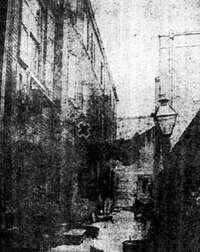 Philadelphia's first Black Hand Haunt (left). The cities Inquire news paper headlines read " Police say they have unearthed Mafia Haunt in - Little
Philadelphia's first Black Hand Haunt (left). The cities Inquire news paper headlines read " Police say they have unearthed Mafia Haunt in - Little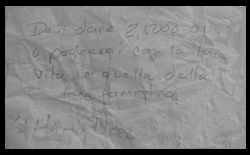 Italy. In the rear of 808 Catherine street in the city's south Philadelphia section. Police claim they have located a branch of the Italians secret Society. A resident claims he was threatened with violence, unless he paid money. The "x" indicates the exact location of the raid. This Black Hand extortion note (right) translates "We want $2,500.00 under penalty of death to himself and family, BLACK HAND.
Italy. In the rear of 808 Catherine street in the city's south Philadelphia section. Police claim they have located a branch of the Italians secret Society. A resident claims he was threatened with violence, unless he paid money. The "x" indicates the exact location of the raid. This Black Hand extortion note (right) translates "We want $2,500.00 under penalty of death to himself and family, BLACK HAND.
The phrase Black Hand would eventually phase out to other Italian monikers. Mafia, La Cosa Nostra on up to disrespectful names from younger Italian gangsters towards older gangsters called mustache petes. With Black Hand controlling the Italian communities through extortion and fear. Omerta is that any member of the organization must maintain absolute silence when questioned by law enforcement, and was the motto for the Italian criminal practitioners.
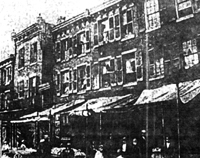 This Philly Newspaper photo (left) was the seen of a Black Hand Bombing. Located at 907 ,909 S. 9th St. according to the proprietors Mr. Volpe and Marstae they received a demand note weeks before demanding money from the Black Hand. Although State and local cops couldn't prove a an organized society at the time. The Black Handers were common knowledge to Italians. By the time of the Black Hand Philadelphia absorbed several surrounding burroughs enabling law enforcement more lead way in enforcing the law., but the secrecy of Omerta was something the cops were unable to break, nor understand. The Philadelphia Police started to recruit Italians to the mainly Irish force, but that was a internal war all it's own. Italians were untrusted by their peers.
This Philly Newspaper photo (left) was the seen of a Black Hand Bombing. Located at 907 ,909 S. 9th St. according to the proprietors Mr. Volpe and Marstae they received a demand note weeks before demanding money from the Black Hand. Although State and local cops couldn't prove a an organized society at the time. The Black Handers were common knowledge to Italians. By the time of the Black Hand Philadelphia absorbed several surrounding burroughs enabling law enforcement more lead way in enforcing the law., but the secrecy of Omerta was something the cops were unable to break, nor understand. The Philadelphia Police started to recruit Italians to the mainly Irish force, but that was a internal war all it's own. Italians were untrusted by their peers.
PHILLY'S FIRST GODFATHER
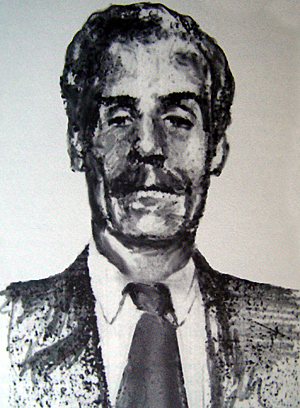 Salvatore Sabella (left) Born in Sicily 1891. The Philadelphia, Pennsylvania faction of La Cosa Nostra has been one of the strongest families in the American Cosa Nostra since its start in 1911. Salvatore Sabella was sent to Philadelphia by the bosses of the Sicilian Mafia to organize the city's rackets. Sabella was the boss of the Philadelphia mob from 1911 until his death in 1927. He was succeeded by Joseph Bruno (no relation to Angelo Bruno). Bruno was in power essentially from 1927 until 1946. There was a period during his rule when his power was challenged by John Avena. This was sometime between 1934 and 1936. Bruno retained his power, but died in 1946. Joseph Ida was the family's next boss. He was in control of the family until a narcotics conviction forced him to flee to Sicily in 1959. His successor was Angelo Bruno. Bruno, son of Joseph Bruno, would be the man to put the Philadelphia Mafia on the map. Bruno was one of the men who got Atlantic City started up. Sabella became the founding mob boss of the Philadelphia, Pennsylvania mob family. In 1920 Salvatore was a olive oil and cheese merchant, and the successful owner of a soft drink cafe. In 1925 he is the suspected shooter of rival mobsters Leo Lanzetti, Vincent Cocozza, Joseph Zanghi. He started leadership in 1911. He was responsible for teaching future mob bosses John Avena and Angelo Bruno the rackets. In 1931 at the age of forty Sabella retired and handed the reign of the crime family to his first protégé John Avena.
Salvatore Sabella (left) Born in Sicily 1891. The Philadelphia, Pennsylvania faction of La Cosa Nostra has been one of the strongest families in the American Cosa Nostra since its start in 1911. Salvatore Sabella was sent to Philadelphia by the bosses of the Sicilian Mafia to organize the city's rackets. Sabella was the boss of the Philadelphia mob from 1911 until his death in 1927. He was succeeded by Joseph Bruno (no relation to Angelo Bruno). Bruno was in power essentially from 1927 until 1946. There was a period during his rule when his power was challenged by John Avena. This was sometime between 1934 and 1936. Bruno retained his power, but died in 1946. Joseph Ida was the family's next boss. He was in control of the family until a narcotics conviction forced him to flee to Sicily in 1959. His successor was Angelo Bruno. Bruno, son of Joseph Bruno, would be the man to put the Philadelphia Mafia on the map. Bruno was one of the men who got Atlantic City started up. Sabella became the founding mob boss of the Philadelphia, Pennsylvania mob family. In 1920 Salvatore was a olive oil and cheese merchant, and the successful owner of a soft drink cafe. In 1925 he is the suspected shooter of rival mobsters Leo Lanzetti, Vincent Cocozza, Joseph Zanghi. He started leadership in 1911. He was responsible for teaching future mob bosses John Avena and Angelo Bruno the rackets. In 1931 at the age of forty Sabella retired and handed the reign of the crime family to his first protégé John Avena.
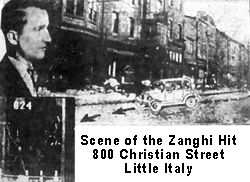 Savatore Sabella tries to snuff out the competition by attempting to rub out the Zanghi brothers, Musky and Joseph, along with Scabby Cocozza, but succeeds only in
Savatore Sabella tries to snuff out the competition by attempting to rub out the Zanghi brothers, Musky and Joseph, along with Scabby Cocozza, but succeeds only in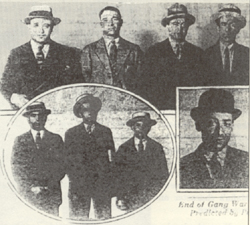 killing Joseph and Scabby. Sabella along with his gang, John Avena, Antonio Pillina, with John Scopoletti behind the wheel, drove off, after the mob hit. Musky Zanghi the actual target of the hit survived and became the mobs first rat. The newspapers headlines banner “The Underworld’s First Squealer”.
killing Joseph and Scabby. Sabella along with his gang, John Avena, Antonio Pillina, with John Scopoletti behind the wheel, drove off, after the mob hit. Musky Zanghi the actual target of the hit survived and became the mobs first rat. The newspapers headlines banner “The Underworld’s First Squealer”.
Police photo at the right, shows the Sabella gang brought in for questioning. Drive by shooting stabbing. became common in the area of little Italy's 9th and Christian Streets. during the roaring twenties, the 800 Block of Christian Street was known as dope row. In the shadow of one of Little Italy's most beloved National Catholic Churches. Drugs, Murder, Racketeering and bootlegging, became a way of life of a lot of the churches parishioners.
Anthony "Tony the Stinger" Cugino
The Stinger was 'Public Enemy No.1' in Philly's first formal police bulletin issued Febuary 1934. Born 1898 Anthony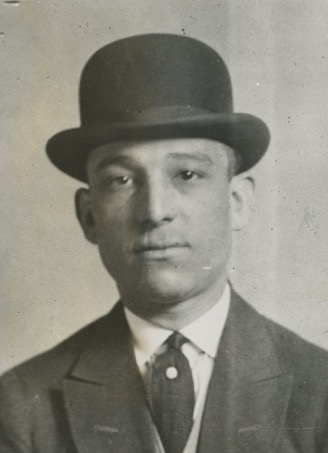 Cugino (pictured right) was as violent as his modern day protege Nicky Scarfo. Rising violently and quickly through the city of brotherly loves crime world. Cugino was also believed to be a one time leader of the Tri State Gang along with his crew Mais and Legenza. The Stinger murdered everyone from cops to women and other gangsters who he believed were a threat, or who he thought did or would cross him. So evil he even buriedied a women alive to get hismessage across. In August 1933 The Stinger was the trigger man behind the famous Philly hit on Anthony 'Musky' Zhangi. In the end Cugino would hook up with gun mole Marie McKeever (right), one of the Tri State Gangs women. Tony the Stinger would be found in his cell dead by suicide. Stinger hung himsel leaving a note to his wife Francis at the time, asking her to forgive Sally signed Jim. Stinger did admit to one of his many murderes before his death. He admitted to killing Philadelphia Police Officer Charles Stockberger, in one of his many holdups.
Cugino (pictured right) was as violent as his modern day protege Nicky Scarfo. Rising violently and quickly through the city of brotherly loves crime world. Cugino was also believed to be a one time leader of the Tri State Gang along with his crew Mais and Legenza. The Stinger murdered everyone from cops to women and other gangsters who he believed were a threat, or who he thought did or would cross him. So evil he even buriedied a women alive to get hismessage across. In August 1933 The Stinger was the trigger man behind the famous Philly hit on Anthony 'Musky' Zhangi. In the end Cugino would hook up with gun mole Marie McKeever (right), one of the Tri State Gangs women. Tony the Stinger would be found in his cell dead by suicide. Stinger hung himsel leaving a note to his wife Francis at the time, asking her to forgive Sally signed Jim. Stinger did admit to one of his many murderes before his death. He admitted to killing Philadelphia Police Officer Charles Stockberger, in one of his many holdups.
***Coming soon - Philadelphia's Meadows Mob***
***Coming soon - William "Big George" Phillips gang***
PHILLY'S BLACKS CONTROL THE NUMBER RACKETS
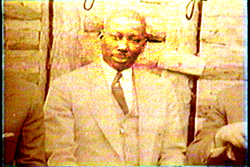 Jonathan Saint Claire AKA West Indian Johnny (pictured left). A gambler from the Caribbean immigrated to Philadelphia in the
Jonathan Saint Claire AKA West Indian Johnny (pictured left). A gambler from the Caribbean immigrated to Philadelphia in the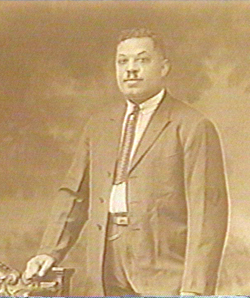 early 19th century. He introduced the numbers racket to the entire east coast, for a penny you would get $4.00, for a nickel you got $22.50, and for a dime you would get $44.00. The three numbers were based on the last three numbers sold on the Stock Exchange. Forrest White Woodard came to Philadelphia from Virginia 1898 (pictured right) by 1922 he was running the biggest numbers operation in the city. By 1930 he became the richest Black man in Philly. The Following year he and the Black Numbers racket was taken over by violent Italian and Jewish Gangsters, headed by the notorious Lanzetti Brothers, the numbers racket was absorbed by the Lanzetti's and Woodard Retired into Legitimate a business. Philadelphia Blacks were forced out of the City wide syndicates. They were reduced running there own neighborhood book and betting parlors. Black book makers and racketeers became the backers for black business and churches who couldn't get loans from white banks. Actor Delroy Lindo in his portrayal of the bipolar numbers boss West Indian Archie in Spike Lee's Malcolm X is actually believed to be Jonathan Saint Claire AKA West Indian Johnny from Philadelphia, but artistic license was taken because the movie is set in New York.
early 19th century. He introduced the numbers racket to the entire east coast, for a penny you would get $4.00, for a nickel you got $22.50, and for a dime you would get $44.00. The three numbers were based on the last three numbers sold on the Stock Exchange. Forrest White Woodard came to Philadelphia from Virginia 1898 (pictured right) by 1922 he was running the biggest numbers operation in the city. By 1930 he became the richest Black man in Philly. The Following year he and the Black Numbers racket was taken over by violent Italian and Jewish Gangsters, headed by the notorious Lanzetti Brothers, the numbers racket was absorbed by the Lanzetti's and Woodard Retired into Legitimate a business. Philadelphia Blacks were forced out of the City wide syndicates. They were reduced running there own neighborhood book and betting parlors. Black book makers and racketeers became the backers for black business and churches who couldn't get loans from white banks. Actor Delroy Lindo in his portrayal of the bipolar numbers boss West Indian Archie in Spike Lee's Malcolm X is actually believed to be Jonathan Saint Claire AKA West Indian Johnny from Philadelphia, but artistic license was taken because the movie is set in New York.
PHILLY'S FIRST DRUG KINGPINS
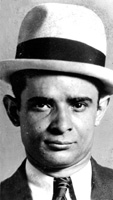 ......
......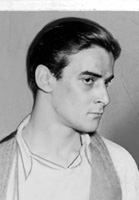 ......
......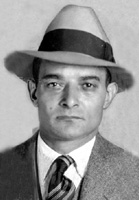 ......
......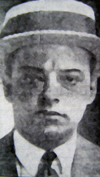
Willie Pius Teo Leo
The six Lanzetti brothers, Leo, Pius, Willie, Ignatius, Lucian, and Teo, were notorious gunman, numbers gamblers, narcotics dealers, and liquor bootleggers in South Philadelphia during the 1920s and 1930s. The Lanzettis organized an "Alky Cooking" supply network by providing a contingent of row house dwellers with home stills and paying them to produce saleable liquor. The Lanzettis then sold the liquor at marked up prices. Their most trusted associates included Louis "Fats" Delrossi and Michael Falcone. At various times, the Lanzettis feuded with several different groups of racketeers in South Philadelphia, as well as with Mickey Duffy and some of his partners. The Lanzettis' criminal careers were marked by frequent arrests and brutal violence. Between 1924 and 1939, at least one brother was involved as a suspect or a material witness in no less than fifteen murder cases, including Pius' detainment (and dismissal) during the early stages of the investigation into the murder of Mickey Duffy. Leo, the eldest, was killed on August 22, 1925, as he left a barber shop at 7th and Bainbridge Streets, in an apparent retribution for the murder of a rival dope peddler and bootlegger, Joseph Bruno. He had been killed by Leo and Ignatius, four days earlier at 8th and Catherine Streets. Enemy bullets claimed the lives of Pius, on New Year's Eve, 1936, and Willie, on July 2, 1939. The Lanzettis became something of a local media fixture during their heyday. Each brother was given a distinctive character trait in stories written about the family of gangsters: Leo, before his murder, was the family leader; Pius was the "Brain;" Ignatius was always impeccably dressed; Lucian had the most explosive temper; Willie was the quiet one; and Teo, the "Baby" of the family, made women swoon with his matinee idol good looks. By 1940, however, the Lanzetti name virtually disappeared from the Philadelphia crime scene. Leo, Pius, and Willie were dead. Teo was in Levenworth Prison on a drug trafficking conviction. Ignatius, released by the U.S. Supreme Court decision declaring unconstitutional the New Jersey "Gangster Law" under which he and Delrossi had been held in prison since 1936, was said to have joined Lucian and their mother in fleeing to Detroit after Willie's death.
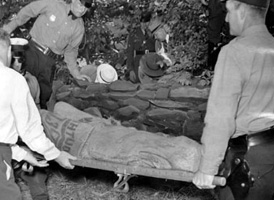 ...................................
...................................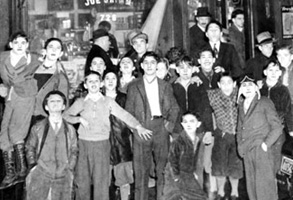
(Photo upper left) Police recover the body of gangster Willie Lanzetti from underbrush in Wynnewood, Pennsylvania. 1939.
(Photo upper right) Children gather outside store on South 8th Street where Pius Lanzetti was murdered. 1936
THE JEWISH MOB
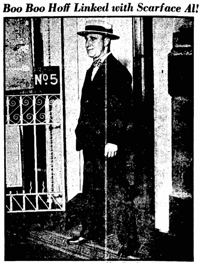
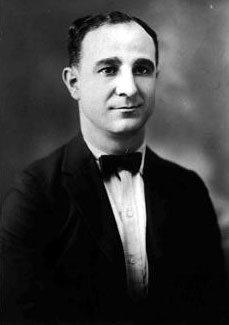 Max "Boo Boo" Hoff, King of the Philadelphia Bootleggers 1928. Born to immigrant Jewish parents in South Philadelphia, Hoff rose to become the "king of Philadelphia bootleggers." "Boo Boo" was the chief proprietor of businesses involved in the diversion of industrial alcohol, including the Quaker Industrial Alcohol Company, the Glenwood Industrial Alcohol Company, and the Consolidated Ethyl Solvents Company. His two closest bootlegging allies were Charles Schwartz and Samuel Lazar. Their diversion plants were protected by police and politicians with whom the Hoff group had arranged protection. Hoff also had interests in several upscale clubs, including the Ship, the Piccadilly, and the Turf Club. Hoff participated in Philadelphia and Atlantic City gambling ventures before, during, and after prohibition. Hoff avoided lending his own name to bootlegging fronts by working through the Franklin Mortgage and Investment Company and the Union Bank and Trust Company. The funds were then channeled into legal investments, primarily in real estate ventures. Hoff headquartered his operations from a suite on the second floor of the Sylvania Hotel in center city. Hoff was never prosecuted as a bootlegger, despite evidence collected by the 1928 Grand Jury probe that he was involved in liquor and weapons distribution. Hoff was perhaps better known, in his day, as a top boxing manager and promoter, rivaled locally only by Herman "Muggsy" Taylor and Phil Glassman. His Ship Club was a popular hangout for the sporting crowd. Much of his fortune was lost during the depths of the Great Depression. Repeal made his diversion plants obsolete, and his tax battles with federal authorities coupled with the excessive spending and betting habits typical of Hoff and his peers finally drained his coffers. In 1941, he died quietly in his bed. Hoff was 46.
Max "Boo Boo" Hoff, King of the Philadelphia Bootleggers 1928. Born to immigrant Jewish parents in South Philadelphia, Hoff rose to become the "king of Philadelphia bootleggers." "Boo Boo" was the chief proprietor of businesses involved in the diversion of industrial alcohol, including the Quaker Industrial Alcohol Company, the Glenwood Industrial Alcohol Company, and the Consolidated Ethyl Solvents Company. His two closest bootlegging allies were Charles Schwartz and Samuel Lazar. Their diversion plants were protected by police and politicians with whom the Hoff group had arranged protection. Hoff also had interests in several upscale clubs, including the Ship, the Piccadilly, and the Turf Club. Hoff participated in Philadelphia and Atlantic City gambling ventures before, during, and after prohibition. Hoff avoided lending his own name to bootlegging fronts by working through the Franklin Mortgage and Investment Company and the Union Bank and Trust Company. The funds were then channeled into legal investments, primarily in real estate ventures. Hoff headquartered his operations from a suite on the second floor of the Sylvania Hotel in center city. Hoff was never prosecuted as a bootlegger, despite evidence collected by the 1928 Grand Jury probe that he was involved in liquor and weapons distribution. Hoff was perhaps better known, in his day, as a top boxing manager and promoter, rivaled locally only by Herman "Muggsy" Taylor and Phil Glassman. His Ship Club was a popular hangout for the sporting crowd. Much of his fortune was lost during the depths of the Great Depression. Repeal made his diversion plants obsolete, and his tax battles with federal authorities coupled with the excessive spending and betting habits typical of Hoff and his peers finally drained his coffers. In 1941, he died quietly in his bed. Hoff was 46.
 ...............
...............
(upper left) Max "Boo Boo" Hoff (wearing bow tie) appears in Federal Court on counterfeit money charges. 1934
(upper right) Boxing promoter Max "Boo Boo" Hoff and four fighters that he managed. Ca.1930s
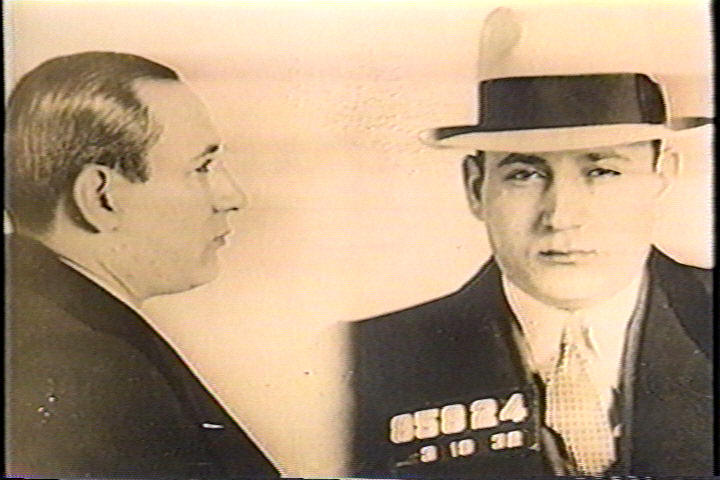 Harry "Nig" Rosen (left) was a Philadelphia mobster who was a major organized crime figure on the east coast with influence as far as Atlantic City, Baltimore and Washington, DC. Born Harry Stromberg, Rosen emerged as a prominent racketeer in southeast Philadelphia and, as head of the 69th Street Gang, became involved prostitution, extortion, labor racketeering and later in narcotics with Arnold Rothstein during the mid-1920s. Succeeding Max "Boo Hoo" Hoff as the cities chief bootlegger during Prohibition, he was a member of the "Big Seven" aligned with the Philadelphia faction along with Waxy Gordon and Irving Blitz, later attending the Atlantic City Conference. During the 1930s, he and Lansky worked on expanding drug trafficking operations in Mexico as an alternative to older routes such as Japan now closed with United States entry into the Second World War. By 1939, a lucrative heroin network had been established from drug traffickers based in Mexico City to major cities across the United States including New York, Philadelphia, Miami and Los Angeles as well as Havana, Cuba. He and his lieutenant, driver and bodyguard William "Willie" Weisberg, were named as dominant racketeers involved in the numbers racket under testimony from police superintendent George F. Richardson during the Kefauver Committee in 1951.
Harry "Nig" Rosen (left) was a Philadelphia mobster who was a major organized crime figure on the east coast with influence as far as Atlantic City, Baltimore and Washington, DC. Born Harry Stromberg, Rosen emerged as a prominent racketeer in southeast Philadelphia and, as head of the 69th Street Gang, became involved prostitution, extortion, labor racketeering and later in narcotics with Arnold Rothstein during the mid-1920s. Succeeding Max "Boo Hoo" Hoff as the cities chief bootlegger during Prohibition, he was a member of the "Big Seven" aligned with the Philadelphia faction along with Waxy Gordon and Irving Blitz, later attending the Atlantic City Conference. During the 1930s, he and Lansky worked on expanding drug trafficking operations in Mexico as an alternative to older routes such as Japan now closed with United States entry into the Second World War. By 1939, a lucrative heroin network had been established from drug traffickers based in Mexico City to major cities across the United States including New York, Philadelphia, Miami and Los Angeles as well as Havana, Cuba. He and his lieutenant, driver and bodyguard William "Willie" Weisberg, were named as dominant racketeers involved in the numbers racket under testimony from police superintendent George F. Richardson during the Kefauver Committee in 1951.
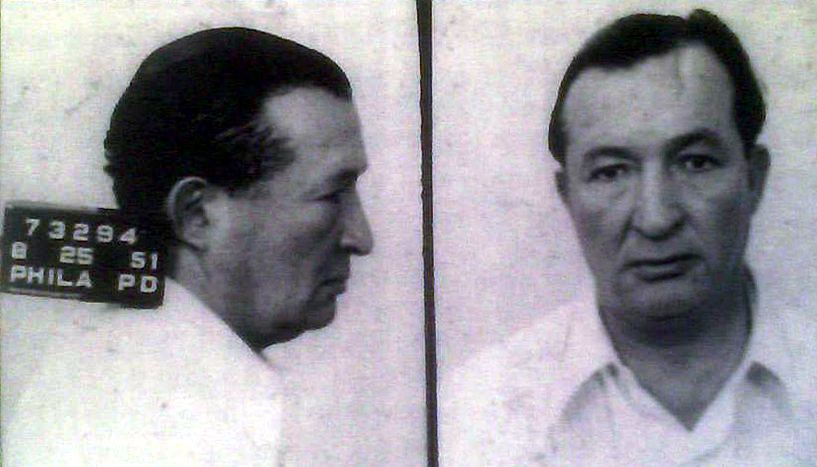 ......
......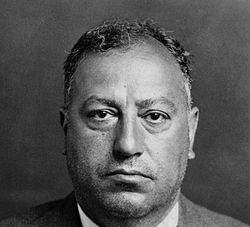 ......
......, Martin Martinson, Abraham Goldberg, Jack Feldman, Irving Blitz, and Edward Kane, Emilio Strollo behind Kane..jpg)
Samuel "Cappy" Hoffman - Waxy Gordon - Irving Blitz, center front row
THE IRISH MOB
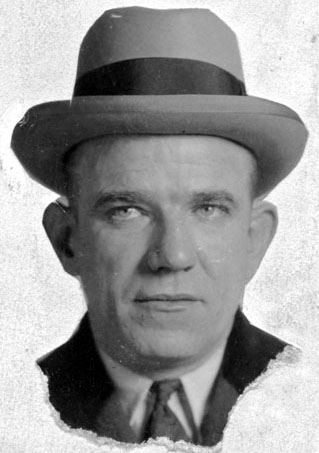
Mickey Duffy (1888-1931) Born William Michael Cusick,(right)his collection of Irish pseudonyms, including John Murphy, George McEwen, and most famously, Michael "Mickey" Duffy, masked the fact that his parents were Polish immigrants. Duffy was involved in petty crimes as a young adolescent, and gradually moved on to more serious offenses. He was involved in armed robbery and truck hijacking before rising to become the most famous of the beer bootleggers in the Delaware Valley. Duffy owned "high powered beer" breweries in Philadelphia, Camden, and South Jersey.
His most frequent partners included Max Hassell (a former rival based in Reading), Harry Green, James Richardson, Charles Bodine, and Nicholas Delmore. Duffy also became the owner of several upscale clubs, including the Perkin and the Cadix. On February 25 1927, an attempt was made on Duffy's life as he left the Cadix. The alleged perpetrators were Peter Ford and Francis Bailey, members of a rival beer bootlegging group headed by Bailey and his two brothers, James and Harry. In 1930, the murder of John Finiello, a federal prohibition agent conducting a raid on an Elizabethtown, New Jersey brewery owned by Duffy and several partners, caused efforts to clamp down on Duffy's activities to be intensified. A rift apparently developed between Duffy and some of his associates including his body guard and chauffeur, Joseph Beatty. On August 31, 1931, while staying at the Ambassador Hotel in Atlantic City, Duffy was murdered. The case was never solved, although the alleged perpetrators were said to be comprised of disgruntled partners plotting to seize Duffy's share of the beer market. In December 1931, two of the accused conspirators, Samuel E. Grossman and Albert Skale, were murdered at a club on Watts Street and Girard Avenue in Philadelphia. Another wave of gang killings was underway, this time among three separate factions of bootleggers once tied in some way to Duffy.
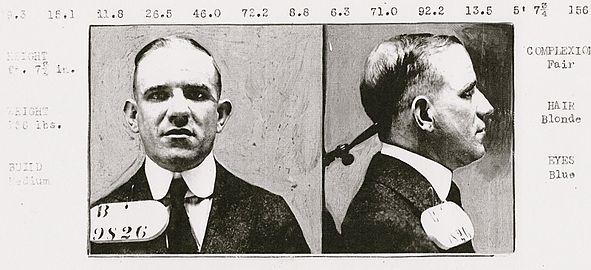 Duffy was named either Michael or William at birth in the Grays Ferry district of Philadelphia sometime around 1888. Mickey was arrested for the first time in 1908, which would actually make him 20. Duffy was sent up in May 1919 for assault and battery with intent to kill. He served almost three years at Philadelphia’s Eastern State Penitentiary, where Al Capone would also sit out the St. Valentine’s Day Massacre. When Mickey got out, he was released into the world of Prohibition. He got married to Edith Craig and opened up his own bootleg operations. He started with smuggling booze into Philadelphia, but soon began brewing it himself.
Duffy was named either Michael or William at birth in the Grays Ferry district of Philadelphia sometime around 1888. Mickey was arrested for the first time in 1908, which would actually make him 20. Duffy was sent up in May 1919 for assault and battery with intent to kill. He served almost three years at Philadelphia’s Eastern State Penitentiary, where Al Capone would also sit out the St. Valentine’s Day Massacre. When Mickey got out, he was released into the world of Prohibition. He got married to Edith Craig and opened up his own bootleg operations. He started with smuggling booze into Philadelphia, but soon began brewing it himself.
Duffy set up breweries in Philly, Camden and South Jersey. He was one of the top bootleggers in the Delaware Valley by the early 20s. He made nice with area mobsters Max Hassell, Harry Green, James Richardson, Charles Bodine and Nicholas Delmore, his main competition. Duffy continued to be a recurring pain to Boo Boo Hassell. Mickey Duffy worked out of the Philadelphia Ritz Carlton on Chestnut and 23rd. Duffy battled it out with other area bootleggers and expanded into the numbers racket.
Like most bootleggers, Duffy took his loot and went into some legit businesses. Also like most bootleggers, he went into those legit businesses that he knew most about. Places that could serve that demon whiskey. Duffy opened some clubs, including the tres chic Club Cadix. On Feb. 25, 1927, he made mob history: Duffy was the target of the first gangster Tommy gun shooting. Duffy was coming out of Club Cadix late at night when gunmen opened fire, hitting him three to five times. The doorman of Club Cadix, Earl Brown, was wounded and Duffy’s bodyguard, John Bricker, was killed. Word on the street is that the fingers on the Thompson submachine gun belonged to Francis Bailey and Peter Ford. Duffy healed up at Hahneman Hospital, where he was given last rites, and went back to work.
By the mid-twenties, Duffy was getting too big for Philadelphia and set his sights on New Jersey. Max Boo Boo Hassel, out of Reading, Pennsylvania, ran breweries all the way up to northern New Jersey. Duffy muscled his way in on Boo Boo’s turf and took over one of his breweries. Hassel was an associate of Waxey Gordon, who ran rum and gambling houses for “The Brain,” Arnold Rothstein.
Beer was good to Mickey Duffy. He made enough bucks brewing suds that he had a Mediterranean villa-style mansion built. It was just outside Philly at 1505 City Line Ave. in the Penn Wynne section of Lower Merion, Pennsylvania. Duffy’s house was known as the House of the Black Palm or The Black Palm Castle, because it had a black wrought-iron palm tree imprint on the front. Duffy added custom design work, detailed it with marble and mahogany, put in a room with steel walls and an electric door and an expensive alarm system. Duffy moved in with his wife. He had his associates move in as neighbors.
Philadelphia District Attorney John Monaghan called Duffy, the "King of the Numbers Racket." Duffy got heat after Prohibition Agent John Finiello was killed in a raid at one of his breweries in Elizabeth, N.J., on September 19, 1930. Local cops cracked down on all Duffy's doings and it pissed off Joseph Beatty, Duffy’s chauffer and bodyguard.
If you snooze, you lose. Duffy was killed while taking a nap at the Ambassador Hotel in Atlantic City in what looks like a power grab on Aug. 31, 1931. He was 39 or 42 depending on reports. The case is still officially unsolved, but that’s just the law. The guys that shot Duffy, Samuel E. Grossman and Albert Skale, were hit two months at a club on Watts Street and Girard Avenue in December 1931. The payback started a mob war in Philadelphia. Thousands came to see Duffy off, the line of mourners stretched down City Avenue, near 77th Street, but cops only allowed the family and some friends with special passes to attend the funeral. The next day, a 31-car procession moved his body to Mount Moriah Cemetery in Philadelphia. Duffy was buried in a solid bronze coffin.
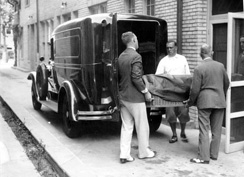 .
.  .
.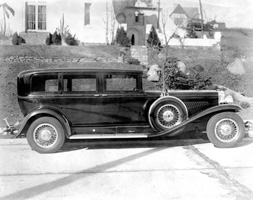 .
.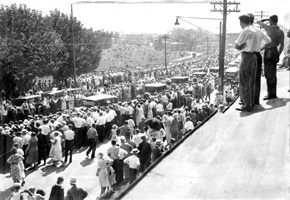
Murdered body of Mickey Duffy removed from the Ambassador Hotel in Atlantic City. 1931
Reenactment of the attempted murder of Micky Duffy outside the Cadix Club. 1927
Mickey Duffy's prize possession, a $20,000 Dusenberg car. 1931
Crowds watch funeral procession for Micky Duffy in Yeadon, Pennsylvania. 1931
Hugh "Hughie" McLoon and Daniel O'Leary
The unsolved murders of Hugh "Hughie" McLoon, on August 9, 1928 and Daniel O'Leary (right), one of the suspects in the murder, six days later, marked an 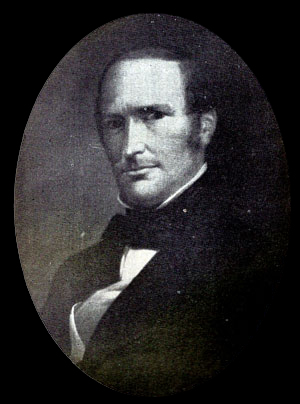 escalation of a wave of periodic violence among many competing bootlegging gangs. The killings touched off the 1928 Special August Grand Jury, which received national attention when it detailed the extent of corruption and bootleggers power in Philadelphia, but produced little in the way of successful indictments.
escalation of a wave of periodic violence among many competing bootlegging gangs. The killings touched off the 1928 Special August Grand Jury, which received national attention when it detailed the extent of corruption and bootleggers power in Philadelphia, but produced little in the way of successful indictments.
On the evening of August 9, 1928, Hugh McLoon, a twenty-six year old little person who was once the bat boy and mascot for the Philadelphia Athletics Baseball team (from 1915-1917) and a night club and sporting scene fixture, was standing outside of the saloon he co-owned at 10th and Cuthbert Streets in Philadelphia. McLoon was chatting with William "Smiling Bill" Meister and John Melko (Alias Joseph Fries), both local bootlegging figures associated with Mickey Duffy. A car drove by, and three gun men opened fire. McLoon was killed. Melko and Meister were wounded, Meister seriously, but both survived. The assailants were said to be Samuel "Shorty" Feldman, Daniel O' Leary, Francis Peterson, and Samuel B. Grossman (who was the driver). Six days later, O' Leary was dead, and the grand jury was convened.
McLoon had a unique role as both an enforcer and violator of the eighteenth amendment. Magistrate Edward Carney gathered evidence of liquor law violations as ordered by Smedley Butler. McLoon also had liquor racket ties. His "Dry Saloon" and cabaret was little more than a thinly veiled speakeasy. In addition, McLoon was often seen around "Boo Boo" Hoff's clubs and had taken up residence in the President Hotel, near Hoff's Suite. After McLoon's murder, both Carney and Hoff expressed their grief over his death and Carney announced that Hoff generously offered to pay McLoon's funeral expenses. McLoon's dual involvement with law enforcement and the liquor racket demonstrates how easily the gap was sometimes bridged between the law and the underworld.
Al Capone visits Philly
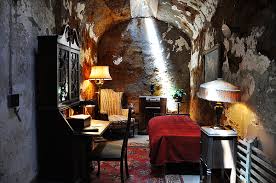 Scarface as he was called, but not his face. Was summoned as all the mob bosses were to Atlantic City. Seems Al's Saint Valentines Massacre was getting ugly with law enforcement and the public. The story goes, he was told to get pinched with gun in Philly and lay low in a Quaker built pinched called Eastern State Penitentiary for a year. The fix was in and Scareface was arrested for carrying a concealed, deadly weapon, this was Capone’s first prison sentence, so the sentence was light for the standards at that time. Chicago’s most famous mob boss spent eight months at Eastern State in 1929-1930. Alphonse's time in Eastern State was spent in relative luxury. His cell on the Park Avenue Block had fine furniture, oriental rugs, and a cabinet radio (pictured right).
Scarface as he was called, but not his face. Was summoned as all the mob bosses were to Atlantic City. Seems Al's Saint Valentines Massacre was getting ugly with law enforcement and the public. The story goes, he was told to get pinched with gun in Philly and lay low in a Quaker built pinched called Eastern State Penitentiary for a year. The fix was in and Scareface was arrested for carrying a concealed, deadly weapon, this was Capone’s first prison sentence, so the sentence was light for the standards at that time. Chicago’s most famous mob boss spent eight months at Eastern State in 1929-1930. Alphonse's time in Eastern State was spent in relative luxury. His cell on the Park Avenue Block had fine furniture, oriental rugs, and a cabinet radio (pictured right).
Special Mention
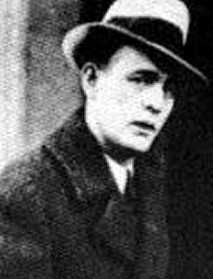 Jack "Legs" Diamond - (1897-December 18, 1931) Yes, Legs Diamond was a Philly Boy. Born in his home in Port Richmond/Fishtown 2530 E. Albert Street although no longer there. Jack Diamond first gang was the Moyer street gang or the Boiler Gang according to the Philadelphia Inquire. At the age of Thirteen his family packed up and moved to Brooklyn. Also known as Gentleman Jack, was the alias of Jack Moran, an Irish-American gangster based out of New York City. A bootlegger and close associate of gambler Arnold Rothstein, he survived a number of attempts on his life between 1919 and 1931, causing him to be known as the "clay pigeon of the underworld." In 1930, Diamond's nemesis Dutch Schultz remarked to his own gang, "Ain't there nobody that can shoot this guy so he don't bounce back?" Diamond is known for having a rather flamboyant lifestyle. He was a very energetic individual, and was very loyal, but he could just as easily double cross you and kill you if he saw fit. His nickname "Legs" derived from the speculation that he was a good dancer, and while this may be true, the nickname really derives from how fast he could get away from his enemies. His wife, Alice Diamond was never supportive of his lifestyle, but she never really said much to persuade him to get away from it. He cheated on her as well, with showgirl and dancer, Marion "Kiki" Roberts. He also cheated on her, with other women that he found around. The public loved him. He was Upstate New York's biggest celebrity at the time.
Jack "Legs" Diamond - (1897-December 18, 1931) Yes, Legs Diamond was a Philly Boy. Born in his home in Port Richmond/Fishtown 2530 E. Albert Street although no longer there. Jack Diamond first gang was the Moyer street gang or the Boiler Gang according to the Philadelphia Inquire. At the age of Thirteen his family packed up and moved to Brooklyn. Also known as Gentleman Jack, was the alias of Jack Moran, an Irish-American gangster based out of New York City. A bootlegger and close associate of gambler Arnold Rothstein, he survived a number of attempts on his life between 1919 and 1931, causing him to be known as the "clay pigeon of the underworld." In 1930, Diamond's nemesis Dutch Schultz remarked to his own gang, "Ain't there nobody that can shoot this guy so he don't bounce back?" Diamond is known for having a rather flamboyant lifestyle. He was a very energetic individual, and was very loyal, but he could just as easily double cross you and kill you if he saw fit. His nickname "Legs" derived from the speculation that he was a good dancer, and while this may be true, the nickname really derives from how fast he could get away from his enemies. His wife, Alice Diamond was never supportive of his lifestyle, but she never really said much to persuade him to get away from it. He cheated on her as well, with showgirl and dancer, Marion "Kiki" Roberts. He also cheated on her, with other women that he found around. The public loved him. He was Upstate New York's biggest celebrity at the time.
THE WAR YEARS
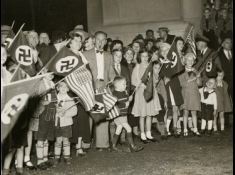 Philadelphia like every other city's law enforcement in America was busy hunting for spies and other groups trying to circumvent the war effort, and the mob was enlisted to help. Many Italian mobsters had ties to Italy and Sicily's illicit underground, and the need for information on Mussolini's Italy was crucial. The Japanese being interned was no threat. Although the German American bund was a serious threat to the countries war effort. The photograph (left) shows a meeting of the Bund at a local German club at 6th and Erie avenue just before the war. Once war was declared the Bund and Nazi sympathizers had to take their activity underground. Active in Philadelphia the Bund surveillance needed a lot of man power, leaving the gangsters at the time of the war abel to run their illegal enterprises easier. As the war ended the economy was booming. Booze was legal and jobs were plentiful, but vices were still in demand.
Philadelphia like every other city's law enforcement in America was busy hunting for spies and other groups trying to circumvent the war effort, and the mob was enlisted to help. Many Italian mobsters had ties to Italy and Sicily's illicit underground, and the need for information on Mussolini's Italy was crucial. The Japanese being interned was no threat. Although the German American bund was a serious threat to the countries war effort. The photograph (left) shows a meeting of the Bund at a local German club at 6th and Erie avenue just before the war. Once war was declared the Bund and Nazi sympathizers had to take their activity underground. Active in Philadelphia the Bund surveillance needed a lot of man power, leaving the gangsters at the time of the war abel to run their illegal enterprises easier. As the war ended the economy was booming. Booze was legal and jobs were plentiful, but vices were still in demand.
The partnership between Jews and Italians continued well after the end of Prohibition, and well after the war. When Tennessee Senator Estes Kefauver brought his investigatory committee to Philadelphia in 1950-51, he found the familiar pattern of gambling, loan-sharking, labor racketeering, and police payoffs. Kefauver’s committee focused on Jewish organized crime, but the aging gangsters dragged reluctantly before the television cameras were well on their way to retirement, prison, or death. It was Angelo Bruno (1910-80), the “Quiet Don,” who would become the face of a new generation of mobsters in the city of brotherly love.
The Green Street Counts
Mostly of teenage age, but as ruthless as their adult counterparts.
The Green Street Counts were a street gang in Philadelphia, "the most menacing gang of teenagers," according to Detective Captain James Kelly, "ever to get together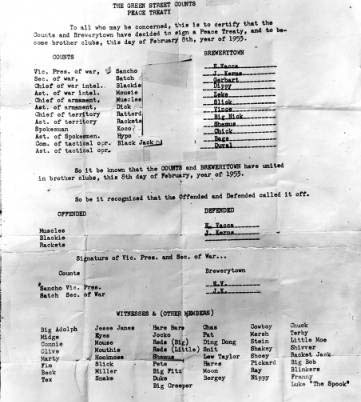 in this city." The Green Street Counts were active in the early 1950s. About the same time (early to mid-1950s) another group of teenagers in Philadelphia took the name Green Street Counts (West). This group of teenagers led by Carlos were operating in a West Philadelphia neighborhood extending from 38th to 47th Streets and Walnut Street to Woodland Avenue. The Green Street Counts (West) were not affiliated with the original Green Street Counts.
in this city." The Green Street Counts were active in the early 1950s. About the same time (early to mid-1950s) another group of teenagers in Philadelphia took the name Green Street Counts (West). This group of teenagers led by Carlos were operating in a West Philadelphia neighborhood extending from 38th to 47th Streets and Walnut Street to Woodland Avenue. The Green Street Counts (West) were not affiliated with the original Green Street Counts.
"The urban gang syndrome had just begun, led by the infamous Green Street Counts, and Bell repairmen would not go into some parts of the city after dark ...The vicious saga of the Green Street Counts hit headlines in the summer of 1953. Where the tragedy of the Head Hunters resulted from a more or less casual association, the Counts were a formalized, cold-blooded organization comparable to mobs of adult racketeers. The gang, with headquarters in the congested area of the city a few blocks north of city hall, had its rigid discipline of obedience to the mob will through fear (one boy was purposely shot in the leg after showing weakness in a robbery executed by the gang). It also boasted an arsenal of firearms. To these familiar attributes of criminal mobs, were added the juvenile touches of a written constitution, in which were designated such officers as "Secretary of War" and "Keeper of the War Chest". Last week- end another gang was discovered by the police in North Philadelphia with the same sort of constitution and by-laws.
In August, the Counts boldly entered a taproom in North Philadelphia, intending to hold up the bartender and patrons at the point of a gun. Panic stricken when their plan failed in execution, they shot their way out. The bartender was shot and instantly killed. One of tlie patrons was injured. Five boys, ranging in age from 16 to 20, were indicted. At this writing, all but one have been tried, found guilty, and sentenced to life imprisonment.
Another extremely troublesome situation which gained prominent newspaper notice was gang rowdyism on central city public transportation. In the fall of 1953, members of the Transport Workers Union employed by the Philadelphia Transportation Corp., complained that on trolley lines servicing students at two central city high schools and one junior high school, gangs of boys had vandalized trolley cars and even robbed motormen. The union officials threatened to stop trolley line service on these important central city communication lines unless immediate steps were taken. It was necessary to station police iu the trolley cars ; and. also at the trolley
stops near the schools. Since that was done no new outbreak has occurred. Less than a month ago, juvenile gang warfare, between two gangs known as the Pandoras and Exiles, resulted in a lioy being shot from a racing automobile by a teen-age gunman. Arrests swiftly followed, but the problem is not alleviated.
These gang situations have proved extremely serious. The office of the district attorney has recommended that a Youth Commission be established by the city of Philadelphia. One of its important functions would be to strengthen social work activities with members of these gangs, in order to turn their energies into constructive or nonharmful recreational activities. Additional functions of the proposed youth commission will be discussed below. Despite the above, the magnitude of the problems treated in juvenile court or the nature of those problems must not be misunderstood. In 1953, juvenile delinquency comprised but 1.9 percent of the juvenile population from 7 to 17 years of age. (In 1952 the rate was 1.7 percent.) Moreover, all the cases which come into court are not concerned with young hoodlums who differ from their adult criminal counterparts only in the differences of age. As a matter of fact, the majority of the cases arise from backgrounds of proverty. family maladjustments, racial prejudice, excessive parental discipline or the lack of it. parental alcoholism, or immorality, or any of the other unfortunate circumstances which may engulf children.
Cases involving runaway or disobedient children do not require the stern measures necessitated by gang cases or the cases of juvenile armed robbery and the like. In many ways, the former cases are more important for here. Mr. Bobo. I notice in your statement you submitted to Mr, Goff, that you spoke of the Green Street Counts and the arsenal that they had. Would you go into that problem? I believe your office was the one that handled that particular problem.
Mr. Gomberg. Well, it started in the juvenile court. However, in our Juvenile Court Act, anyone over 14, if the act is sufficiently severe and the juvenile court feels that a jury trial would be in the interest of justice, can certify the case down to the criminal court. In that particular case the act was so severe that the court did
certify the case to the criminal court, although some were juveniles under 18. In that case, we had a situation where some of the boys up around 21st and Green Streets, which is a distance not so far from here, had gotten together and organized a gang. They did some amazing things. They appointed officers ; they had a keeper of the war chest, a secretary of war. They had a written constitution. They had recently merged with some other gang and had formalized that by a written document. But they were not juvenile at all in the way they approached the robbery of the taproom. They went into a taproom up in North Philadelphia and they had a lookout and so on, but because they were juveniles I think very nervous something happened in the course of their robbery, they killed the bartender and injured one of the patrons in the bar.All of the people in that gang have been tried. They have all been sentenced to life imprisonment, with one exception, who will be tried shortly. That was a very serious situation.
THE NEW FACE OF THE BLACK HAND
The Mafia commonly known as the Italian Mafia, Italian Mob, or the Mob in the United States, is an Italian American criminal society that originated and developed from the Sicilian Mafia. The Italian-American Mafia is a secret criminal society without a formal name, similar to the Sicilian Mafia. Its members usually refer to it as Cosa Nostra (Italian pronunciation: [kɔza nɔstra]), a phrase which literally translates to "our thing," but can be more accurately paraphrased as "our work" or "our operation." The press also coined the name "National Crime Syndicate" to refer to the entire network of U.S. organized crime, which included the Jewish Mafia elements and the Italian-American Mafia. It was described as a confederation of mainly Italian and Jewish-American organized crime groups throughout the U.S., as revealed by the findings of a U.S. Senate Special Committee in the 1950s chaired by Estes Kefauver. The creator of the American Mob was long-time criminal Charles "Lucky" Lucciano
The Appalachian Meeting was a historic summit of the American Mafia held on November 14, 1957 at the home of mobster Joseph Barbara in Appalachian, New York. It was attended by roughly 100 mafia crime bosses from the United States, Canada and Italy. Expensive cars with license plates from around the country aroused the curiosity of the local and state law enforcement, who raided the meeting, causing mafiosi to flee into the woods and the surrounding area of the Appalachian estate. Over 60 underworld bosses were detained and indicted due to the disastrous meeting. The direct and most significant outcome of the Appalachian meeting was that it helped to confirm the existence of a National Crime Syndicate, which some - including J. Edgar Hoover, head of the Federal Bureau of Investigations - had long refused to acknowledge.
ANGELO BRUNO By: David Amoruso
 Angelo "The Gentle Don" Bruno (left) was the last of the old school Philadelphia Mafia Bosses. He was given the nickname "The Gentle Don" because he was like that, he thought everything over and didn't overreact, he handled his business in a quiet way that was good for the Philadelphia Family. Angelo Bruno was by far the most successful boss that the Philadelphia Crime Family ever had. Under his leadership the Family flourished, when he was killed the Family self-destruct.
Angelo "The Gentle Don" Bruno (left) was the last of the old school Philadelphia Mafia Bosses. He was given the nickname "The Gentle Don" because he was like that, he thought everything over and didn't overreact, he handled his business in a quiet way that was good for the Philadelphia Family. Angelo Bruno was by far the most successful boss that the Philadelphia Crime Family ever had. Under his leadership the Family flourished, when he was killed the Family self-destruct.
Angelo Bruno was born on Sicily in 1911 and came to the U.S. in the late 1920s and settled in Philadelphia. Pretty soon Bruno started doing crime. In those days the Philadelphia Mafia boss was Salvatore Sabella. Sabella started the family in 1911. With the surge of Italian immigrants in that area, he had no trouble getting men to do his biding. Bruno had set up a gambling operation and ran some bootlegging operations for Sabella. In 1927 Sabella was deported and John Avenna became the new Boss. Under Avenno Bruno became a made man in the Philadelphia Crime Family this would happen in the early 1930s. In 1934 he formed an important partnership with Carlo Gambino in a lucrative land transaction. In 1959 the boss of the Philadelphia Family Joseph Ida retired and made Antonio Pollina the new boss. Pollina was one of two choices for Ida, the other candidate for the top position was Bruno. Even though Pollina was made boss and had Bruno's total support Pollina didn't feel at ease with a potential rival to his power and so he ordered that Bruno should be whacked. When Bruno heard of this order he went to see his dear old friend Carlo Gambino, who by this time was one of the most powerful bosses in the U.S. Bruno told Gambino of the hit order and Gambino made it clear that his friend would not be whacked. Instead he would be made the new Boss of the Philadelphia Crime Family. Gambino also asked Bruno what he wanted to do with Pollina, Bruno decided to keep him around so the Family could get used to their new leader and not angry them by murdering their old leader. The plan worked and soon Bruno was the undisputed Boss of the Philadelphia Crime Family.
Bruno ruled his Family with a low key style directed mostly to the traditional rackets. He held it tight and strict and always handled business extremely professional. Like the time Bruno had to deal with a guy who was robbing bookmakers connected to the Family. The guy had been warned but wouldn't stop and so Bruno ordered the hit. The contract was given to then soldier Nicky Scarfo (he would become boss in the early 1980s.) The victim was lured to a bar where he was strangled and stabbed to death. Bruno then ordered Scarfo to take the body to a spot in the woods nearby where another Bruno crew had already dug a grave. But Scarfo and his crew were told not to bury the body, they were instructed to leave the body next to the grave. They were told another crew would bury the body. When Scarfo and his crew had left, Bruno sent two of his most trusted men to pick up the body. First they filled the grave with dirt, then they took the body and buried him at another location. That way if any members of the Scarfo crew or the crew originally assigned to dig the grave decided to flip and become informants they'd have nothing to deliver. The grave they went to would be empty. This was what made Bruno the most successful boss in Philadelphia Family history it also gave him the nicknames "The Docile Don" and "The Gentle Don" because he never lost his cool and always handled his business in a professional manner.
Right from the start of his reign as Boss Bruno opposed the Family's involvement in drug trafficking. Bruno didn't want to attract any attention from the D.E.A. or even more attention from the F.B.I. By this time Bruno had been arrested 13 times in his long career. He had been subpoenaed and indicted by grand juries regularly, his only jail term lasted two and a half years for refusing to testify in an investigation of official corruption in Atlantic City. The ban on getting involved with drugs angered several Philadelphia mobsters who saw the money that could be made with drugs. They were even angrier to see that Bruno, although he had decreed a ban on dealing drugs, associated, and took money from several drug dealers, among them the Cherry Hill Gambinos.
In 1977 the gambling act in New Jersey was altered and Philly mobsters had dollar signs in their eyes just thinking of all the money they could make. However Bruno declared Atlantic City open territory, this meant other Mafia Families could come in and operate criminal businesses there. Bruno felt that if he didn't declare Atlantic City open territory he could get his Family into a war with the bigger and more powerful New York Families, declaring open territory made sure that there would be no war. He also told his Family there would be enough for everyone. His Family however felt he was selling out to the New York Families. This along with the ban on drug trafficking would be the reason of Bruno's demise.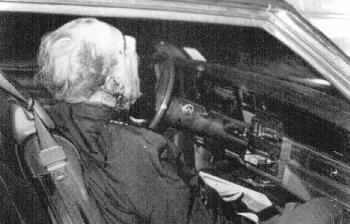
Angelo Bruno whacked in his car. (right) Pretty soon a faction within the Family started to plan the hit on Bruno. The faction was headed by Bruno's consigliere Anthony "Tony Bananas" Caponigro. On March 21, 1980, Bruno, at age 69, was sitting in his car when a man fired a shotgun at him, and in the process wounding John Stanfa, 39, Bruno's bodyguard. Afterwards it is generally believed that Tony Caponigro carried out the hit himself. Angelo Bruno would be the most successful Boss in the history of the Philadelphia Crime Family. With the death of "The Gentle Don" or "The Docile Don" there came an end to the peace that surrounded the Philadelphia Family during his 21 year reign as Boss. His successors would bring the Philadelphia Family down to it's knees and give it the name "The most dysfunctional Mafia Family in the United States".
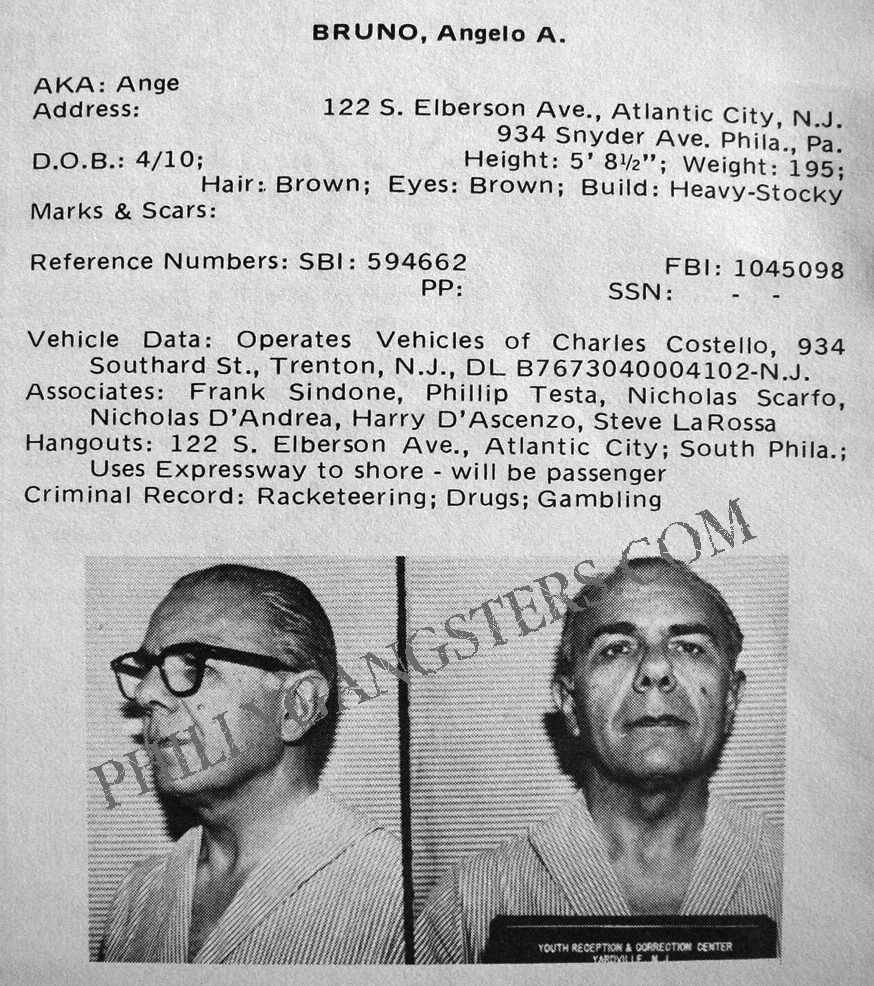
Angelo Bruno had a reputation of forbidding drugs in his organization. But as the mug shot shows, that wasn't true.
The below image shows the Philadelphia mob structure, during it's grandeur.
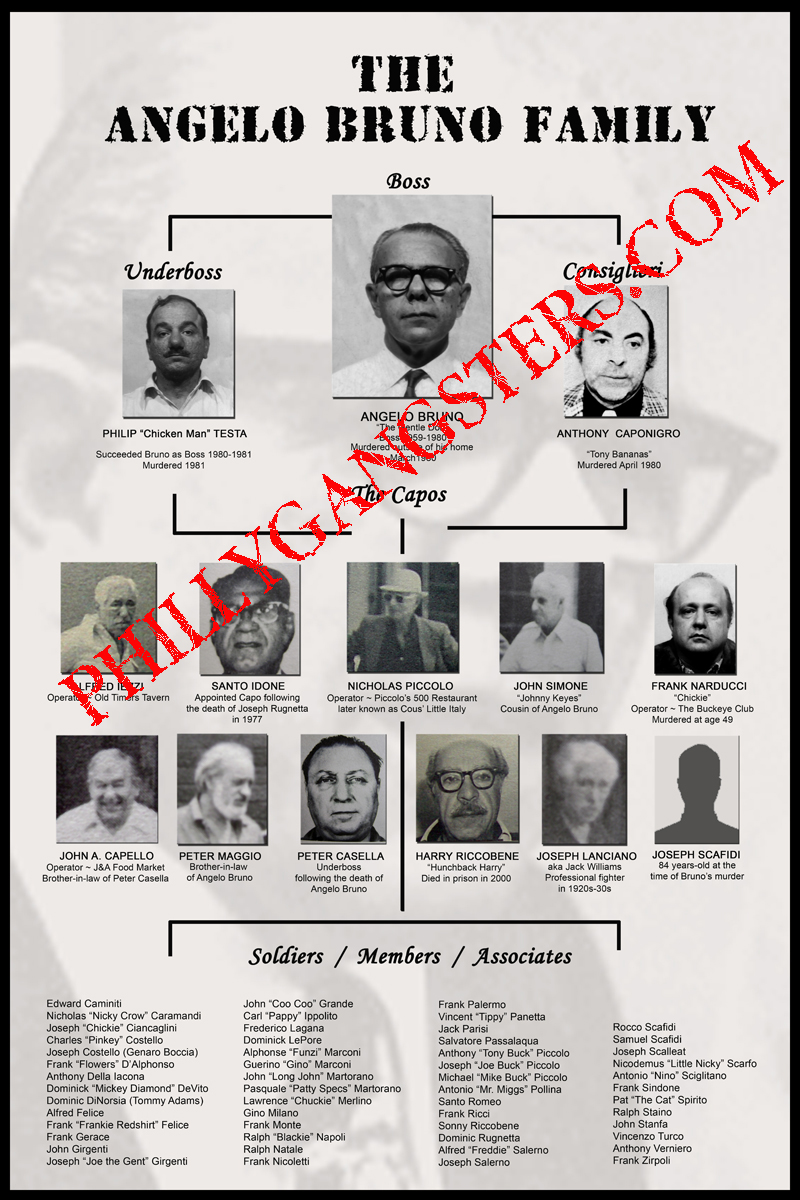
Bruno's gang was held to a tight control by the boss, mentioned before many in his organization didn't like it. The gentile don was satisfied with his rackets and his many incomes. Shake downs, coin machines loan sharking, bookmaking along with other illegal ventures wasn't enough for many in his mafia family. 'Don' Bruno did business with every other ethnic group throughout the city, to the dislike of the old mustache pete's. Allegedly Bruno claims no knowledge of his crime family with drugs. But members and associates under his wing had very large dealings with the drug trade. Long John Martorano for example was one of the major players in the meth trade. The Ricobene's were other members of the group who did business with major drug distributors. Outlaw bikers were also a another group Bruno's gang did business with in the drug business. But 'Don' Bruno's easy ways would soon end, as his demise was being planned. On a quiet South Philly street, Bruno's driver John Stanfa an old school mafia Sicilian immigrant was dropping the boss off outside his home on Snyder avenue. A man stepped out of the shadows and blew the Dons brains out with a shotgun.
Atlantic City, that place where the mafia commission was organized and formed by the infamous Lucky Lucciano began, That dead ocean playground of yesteryear, where Philadelphians and New Yorkers would travel for some fun and sun, and a stroll on the board walk, was about to have new life breathed into it. Casino Gambling was made legal, and many gangsters saw dollar signs, and not through honest work. With the old mustache pete 'don' dead, the sky was the limit.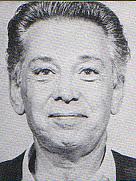
Everyone was moving in on Atlantic city. But AC was Scarfo's territory. Nicky Scarfo (right) was the most bloodiest evil member of the Philadelphia crime family. He even said during a mob hit on Vincent Falcone, as he lay dead "I LOVE THIS SHIT" and pumped another bullet into a rival construction competitor. Angelo Bruno hated Scarfo and would have had him whacked, but Nick was a made guy, and the nephew of one of Bruno's underbosses. Nicky once stabbed a man to death over a misunderstanding about a restaurant table at the South Philly Oregon Dinner. Bruno had him Banished to Atlantic City where it was a dead town at the time and for many years following. But it was the luck of the draw with the new gambling laws in Nicky's town and Little Nicky as he was called was sitting in the drivers seat with the boom of Casino construction.
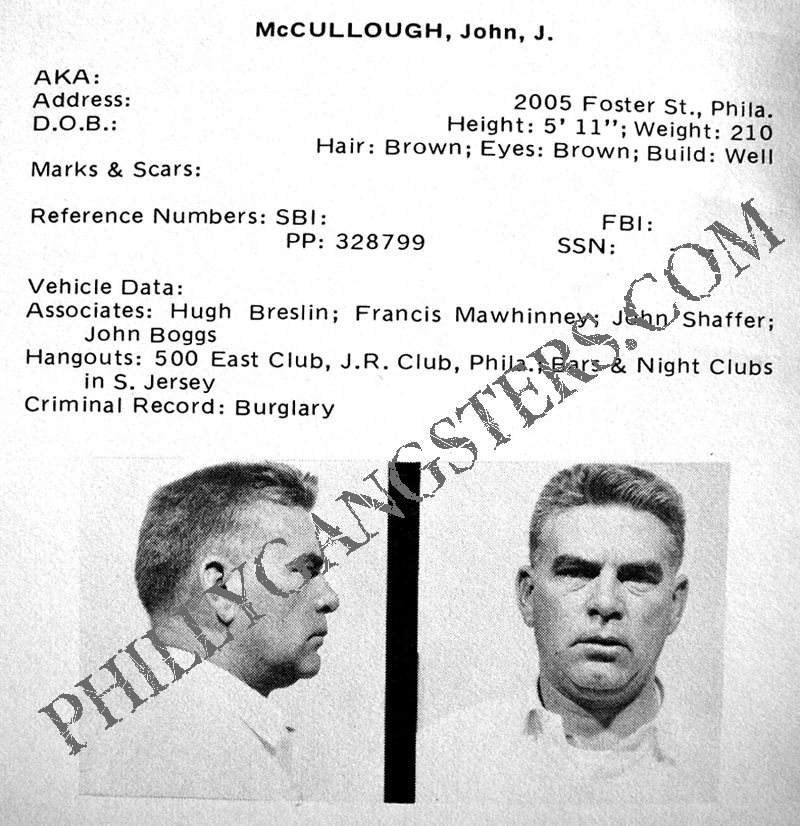 The only problem was a tough as nails Philadelphia Irishman, and K&A gang associate had his sights on the AC casino construction business as well. John McCullough a beloved union leader of Roofers local 30 B was planning his entrance to the Atlantic City enterprise. Immediately he began union organizing. The Bartenders, housekeepers, restaurant workers and security guards were being called to unionize. But Little Nicky Scarfo wasn't hearing any of that stuff. McCullough along with a loyal union following, also had very close ties to the Irish K&A gang. McCullough wasn't unfamiliar with violence and gangster ways, he was an old pro.
The only problem was a tough as nails Philadelphia Irishman, and K&A gang associate had his sights on the AC casino construction business as well. John McCullough a beloved union leader of Roofers local 30 B was planning his entrance to the Atlantic City enterprise. Immediately he began union organizing. The Bartenders, housekeepers, restaurant workers and security guards were being called to unionize. But Little Nicky Scarfo wasn't hearing any of that stuff. McCullough along with a loyal union following, also had very close ties to the Irish K&A gang. McCullough wasn't unfamiliar with violence and gangster ways, he was an old pro.
A local Philadelphia contractor named Leon Altemose owned a construction company he started in 1961 and believed that employees should have a the right to choose if they wanted to belong to a trade union.Altemose won an $18-million construction contract in 1972 for a 24-acre hotel, office and retail complex to be built in the suburbs of Philadelphia. Altemose wanted to employ at least a portion of trade employees as non-union. This led to disputes and protests by union supporters.
A thousand construction workers arrived at the construction site at dawn on June 5, 1972 in cars and buses chartered by Roofers Local Union lead by the pugilist union boss McCullough. More than $300,000 of property damaged occurred, including firebombing of equipment and construction trailers. Fire trucks were not allowed to respond because of the chaos at the site. The destruction would continue until midday when the state police arrived in riot gear. On August 17, 1972, Altemose was assaulted by two dozen men in downtown Philadelphia. The protests were estimated to have cost Altemose more than $2 million. They would delay, but not halt, the completion of construction as the hotel would eventually open in September 1973. The Roofer union leader was warned many times to back of of Nicky's Atlantic City, but McCullough wouldn't budge. As Christmas was approaching McCullough received a flower delivery of poinsettias. The delivery man Willard Moran also delivers bullets to the union bosses head, courtesy of the local mob.
Phillip 'Chicken Man' Testa was Bruno's successor, and Little Nicky Scarfo as his under boss. Gangster business was in full swing in Philly and Atlantic City. Scarfo's cement company was preparing to lay the cement for the casino's, his nephew Phil Leanetti was organizing the workers with union dues kickbacks, and in Philly someone was planning to kill the Chicken Man. Almost one year to the day Angelo Bruno was whacked, Phil Testa went to open his front door in South Philly when a bomb laced with roofing nails exploded killing the Chicken Man. The message was loud and clear, it's retribution for the roofer John McCullough. Word went out quickly K&A gang boss John Berkery ordered the hit, but on a New York visit to the commission underboss Scarfo was apparently told something different. An eye for an eye hit was put on Berkery but was called of when Scarfo returned to Philly. Little Nicky also brought another tid-bit of info back to the city of brotherly love, he was made the new boss of Philadelphia that included Atlantic City. All hell broke out all over the next 3 years 14 hits took place. Scarfo was having all of Bruno's allies whacked, including the Chicken Mans own son Salvie Testa. He even had the head of the Greek mob Steve Bouras executed. along with his lady friend in a crowded restaurant. Scarfo was pissing off the people and law enforcement, and he didn't care.
THE K&A GANG
The K&A gang is best described by Allen Hornbum author of book Confessions of a second story Man, Jr. Kripplebarer and the K&A gang. From the 1950s to the 1970s from Bar Harbor to Boca Raton, the ragtag crew known as the K&A Gang robbed wealthy suburban residences with assembly line skills of breaking, entering, and bagging the loot – be it a rare coin collection or priceless paintings. “It was hard to imagine a more unlikely crew of successful thieves,” writes Allen Hornblum about the gang. “Far from…urbane…[they were] two-fisted, beer-guzzling, ear and nose-biting hoodlums from a blue collar…section of Philadelphia called Kensington.”
K&A any Philadelphia native knows is short for Kensington and Allegheny Avenues, a busy intersection in the eastern section of the city. The gang originated by a two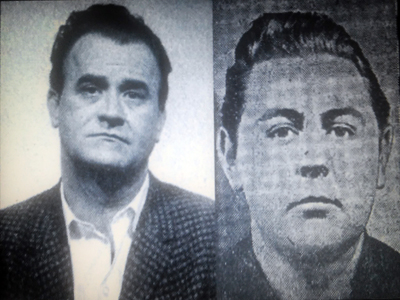 high school dropouts named Effie Burke and Willie Sears pictured (right) sometime near the end of the 1950s they engineered a system of burglary called production work.The two gangsters recruited many of high school drop outs from the Kensington area of the city. Jimmy Dolan, Jackie Johnson, John Berkery, Hughy Breslin, Herman Cable, Junior Kripplebauer, Chickie Goodroe and many more. Unlike the Mafia, The K&A gang known as an Irish gang ran the gambit of Irish, Jews, Italians, Polish and German. Their was was no organized commission, and as time went on, the gang grew into many small crews with no single leader. Freelancing was accepted, but the code of silence was the same as the La Costa Nostra. Police and FBI called them the best burglars in the country. The Woolworth, Dupont families, a State Governor and hundreds of very wealthy capitalists fell victim to their craft. Jewish store owners from the more affluent section of the city were constantly being burgled from the gang. Seems these uneducated hoodlums realized Jewish store owners do their best business on the weekends. As the store owner left with the days profits in cash, the gang would follow them home, then burgle them when they went to the synagogue. You see the banks weren't open on weekends, so we knew the money was in the empty house, said one gangster. The Gang had one rule no guns. If a gun was found during the caper, it was tossed in the toilet water closet and made inoperable. As the years passed on and the gang grew, it got so bad that the police started printing multi page booklets with the gangsters photographs hangouts and associates. Every cop in the area the gang hung out carried those books. Below is a very small sample of K&A gangsters from the pages of those books, but their are over a hundred of them, and shows just how many of these gangster practitioners of production work their were throughout the Kensington section.
high school dropouts named Effie Burke and Willie Sears pictured (right) sometime near the end of the 1950s they engineered a system of burglary called production work.The two gangsters recruited many of high school drop outs from the Kensington area of the city. Jimmy Dolan, Jackie Johnson, John Berkery, Hughy Breslin, Herman Cable, Junior Kripplebauer, Chickie Goodroe and many more. Unlike the Mafia, The K&A gang known as an Irish gang ran the gambit of Irish, Jews, Italians, Polish and German. Their was was no organized commission, and as time went on, the gang grew into many small crews with no single leader. Freelancing was accepted, but the code of silence was the same as the La Costa Nostra. Police and FBI called them the best burglars in the country. The Woolworth, Dupont families, a State Governor and hundreds of very wealthy capitalists fell victim to their craft. Jewish store owners from the more affluent section of the city were constantly being burgled from the gang. Seems these uneducated hoodlums realized Jewish store owners do their best business on the weekends. As the store owner left with the days profits in cash, the gang would follow them home, then burgle them when they went to the synagogue. You see the banks weren't open on weekends, so we knew the money was in the empty house, said one gangster. The Gang had one rule no guns. If a gun was found during the caper, it was tossed in the toilet water closet and made inoperable. As the years passed on and the gang grew, it got so bad that the police started printing multi page booklets with the gangsters photographs hangouts and associates. Every cop in the area the gang hung out carried those books. Below is a very small sample of K&A gangsters from the pages of those books, but their are over a hundred of them, and shows just how many of these gangster practitioners of production work their were throughout the Kensington section.
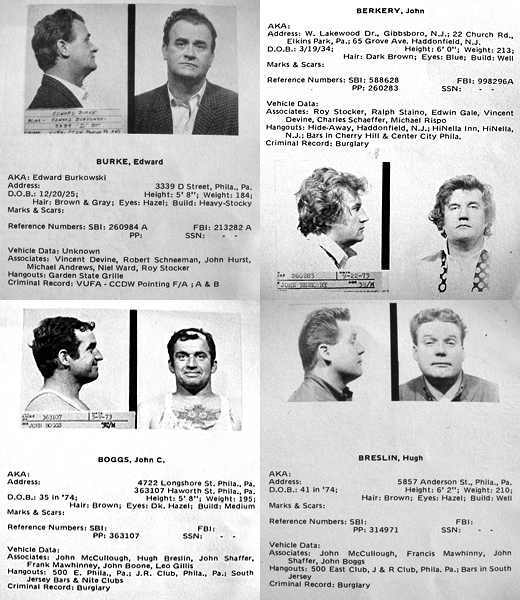
Yet another sample of the police booklets (below)
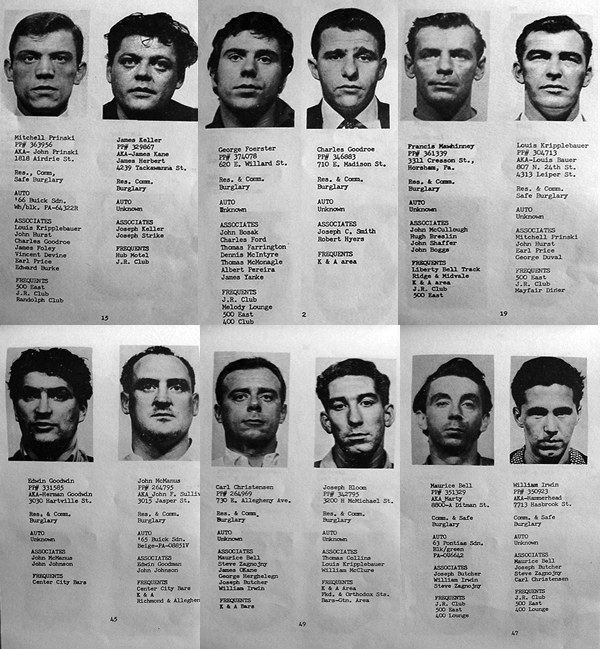
Copies of Mug shots were photocopied sometimes on a daily basis, and delivered to the districts as shown below.
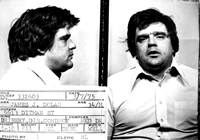 ......
......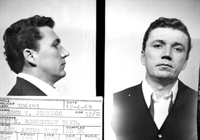 ......
......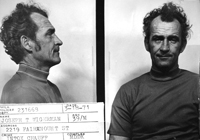
The Cadillac of all burglaries
Law enforcement was frustrated, and beside themselves witht the K&A Burglars, but to ad insult to injury, a burglary would take place in a small pennsylvania coal mining town north of the gangs hometown that would be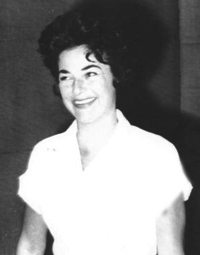 the crime of the century. Lillian Reis (right) a chorus line girl dancing at a Philly hot spot got a tip about a house in Pottstown Pennsylvania. Bing Miller a business man who visited the show girls Haunt had the hots for Lil. After a few drinks he spilled the info on John Rich, a wealthy coal baron who had tons of money in a flimsy safe in his home basement. Junior Stano an associate of the South Philly Mafia and Lils main squeeze passed the info on to one of the K&A burglars John Berkery. Berkery along with two of his crew Vince Blaney and Bobby Poulson, set things in motion. The trio along with Staino headed up to coal country to relieve the coal baron of his loot, and when they opened the safe, it is claimed they scored big, $480,000.00 along with $17,000.00 in Jewelry. Mob boss Calos Marcello of New Orleans had a plaque on his wall that read "Three can keep a secret if two are dead" and in this case it proved very profound. Berkery to his credit knew how to handle a score that big, he kept a low profile about the loot, Lil with her cut opened up her own hot spot called the celebrity room in down town Philly. But Blaney and Poulson were spending money like drunken sailors around kensington, and the story of the caper started to spread like weeds. Philadelphia police inspector Clarence Ferguson got wind of the heist and put his men on the case. Ferguson got a break when Vince Blaney' s brother Richie also a K&A gangster wanted out of Eastern State Penitentiary and was willing to rat his own brother and the others to get out of prison. Ferguson made the deal, but it wouldn't be long before the two Blaney's would end up dead, and Poulson near dead from a botched hit. With no witnesses for evidence charges would eventually be dropped after a long court battle. As time went on Lil would lose her club, Staino would go back to the mob, Poulson would retire to legitimate work, and Berkery would go on to a life of crime. Many of the K&A gang would graduate from Burglary to drugs. But the Pottsville caper was the Cadillac of all the K&As gangster history.
the crime of the century. Lillian Reis (right) a chorus line girl dancing at a Philly hot spot got a tip about a house in Pottstown Pennsylvania. Bing Miller a business man who visited the show girls Haunt had the hots for Lil. After a few drinks he spilled the info on John Rich, a wealthy coal baron who had tons of money in a flimsy safe in his home basement. Junior Stano an associate of the South Philly Mafia and Lils main squeeze passed the info on to one of the K&A burglars John Berkery. Berkery along with two of his crew Vince Blaney and Bobby Poulson, set things in motion. The trio along with Staino headed up to coal country to relieve the coal baron of his loot, and when they opened the safe, it is claimed they scored big, $480,000.00 along with $17,000.00 in Jewelry. Mob boss Calos Marcello of New Orleans had a plaque on his wall that read "Three can keep a secret if two are dead" and in this case it proved very profound. Berkery to his credit knew how to handle a score that big, he kept a low profile about the loot, Lil with her cut opened up her own hot spot called the celebrity room in down town Philly. But Blaney and Poulson were spending money like drunken sailors around kensington, and the story of the caper started to spread like weeds. Philadelphia police inspector Clarence Ferguson got wind of the heist and put his men on the case. Ferguson got a break when Vince Blaney' s brother Richie also a K&A gangster wanted out of Eastern State Penitentiary and was willing to rat his own brother and the others to get out of prison. Ferguson made the deal, but it wouldn't be long before the two Blaney's would end up dead, and Poulson near dead from a botched hit. With no witnesses for evidence charges would eventually be dropped after a long court battle. As time went on Lil would lose her club, Staino would go back to the mob, Poulson would retire to legitimate work, and Berkery would go on to a life of crime. Many of the K&A gang would graduate from Burglary to drugs. But the Pottsville caper was the Cadillac of all the K&As gangster history.
PHILADELPHIA - THE METH CAPITAL OF THE WORLD
By the late 1970s, with the advent of modern home-security technologies, the burglary racket was no longer viable as a main source of income. With the rise of the drug culture of the 1980s, the group began to focus less on their signature brand of thievery and more towards traditional criminal schemes and the booming methamphetamine trade. This was largely due to the immense profit that was available due to the high 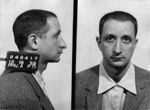 demand in the area. By the early 1980s, John Carlyle Berkery had close ties with Angelo Bruno and Raymond "Long John" Martorano of the Philadelphia crime family. It was through these influential connections that the K&A Gang would expand into other rackets establishing its foothold in the Northeast. In 1983, Philadelphia garnered a reputation as the "meth capital of the world", according to a statement published by the Associated Press, from a local police officer. It is widely held that this was made possible due to the K&A Gang, and the Junior Black Mafia, Outlaw Biker gangs among others. After being indicted for 14 counts of trafficking in methamphetamine and the chemical P2P in January 1982, Berkery fled to Ireland to avoid prosecution.. In the fall of 1987, after spending five years on the run, he was captured in June 1987 and subsequently faced trial. Berkery admitted to engaging in a large scale meth deal with Chelsais Bouras, leader of the Philadelphia Greek Mob. Ronald Raiton, a notable criminal figure in the methamphetamine trade, testified that Berkery had bought 200 gallons of P2P from Raiton over the course of a year in 1980-1981. Prosecutors stated that he and Raymond Martorano (left) had planned to take over all meth trafficking in Philadelphia. Carl "Better Days" Jackson assumed control of the group. Jackson went on to lead the group until his conviction in late 1987, just a week after his former boss faced trial and was also found guilty. Jackson was said to have gained around 4 million dollars in drug profits in the period between his takeover of the gang's meth endeavors and his eventual arrest. He received a lifetime sentence in accordance with the Continuing Criminal Enterprise statute, otherwise known as the "drug kingpin" law. Along with Carl Jackson, 22 affiliates of the K&A meth ring were indicted under federal drug manufacturing charges related to an operation that authorities believe produced roughly ten million dollars worth of speed in hidden labs in the across Pennsylvania area. They were said to have manufactured 100 pounds of methamphetamine at a time, which was then distributed by Jackson's subordinates. At the time US Attorney Edward Dennis claimed in a press release that the gang is "one of the largest methamphetamine organizations in the
demand in the area. By the early 1980s, John Carlyle Berkery had close ties with Angelo Bruno and Raymond "Long John" Martorano of the Philadelphia crime family. It was through these influential connections that the K&A Gang would expand into other rackets establishing its foothold in the Northeast. In 1983, Philadelphia garnered a reputation as the "meth capital of the world", according to a statement published by the Associated Press, from a local police officer. It is widely held that this was made possible due to the K&A Gang, and the Junior Black Mafia, Outlaw Biker gangs among others. After being indicted for 14 counts of trafficking in methamphetamine and the chemical P2P in January 1982, Berkery fled to Ireland to avoid prosecution.. In the fall of 1987, after spending five years on the run, he was captured in June 1987 and subsequently faced trial. Berkery admitted to engaging in a large scale meth deal with Chelsais Bouras, leader of the Philadelphia Greek Mob. Ronald Raiton, a notable criminal figure in the methamphetamine trade, testified that Berkery had bought 200 gallons of P2P from Raiton over the course of a year in 1980-1981. Prosecutors stated that he and Raymond Martorano (left) had planned to take over all meth trafficking in Philadelphia. Carl "Better Days" Jackson assumed control of the group. Jackson went on to lead the group until his conviction in late 1987, just a week after his former boss faced trial and was also found guilty. Jackson was said to have gained around 4 million dollars in drug profits in the period between his takeover of the gang's meth endeavors and his eventual arrest. He received a lifetime sentence in accordance with the Continuing Criminal Enterprise statute, otherwise known as the "drug kingpin" law. Along with Carl Jackson, 22 affiliates of the K&A meth ring were indicted under federal drug manufacturing charges related to an operation that authorities believe produced roughly ten million dollars worth of speed in hidden labs in the across Pennsylvania area. They were said to have manufactured 100 pounds of methamphetamine at a time, which was then distributed by Jackson's subordinates. At the time US Attorney Edward Dennis claimed in a press release that the gang is "one of the largest methamphetamine organizations in the 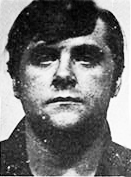 nation." Edward Loney (left - and still a fugitive believed to be living in Ireland) was to have arranged the obtaining of 50 gallons of P2P, a precursor chemical, along with Waldemar "Walter" Roeder from Toronto,
nation." Edward Loney (left - and still a fugitive believed to be living in Ireland) was to have arranged the obtaining of 50 gallons of P2P, a precursor chemical, along with Waldemar "Walter" Roeder from Toronto,  while Jackson sold mass quantities to contacts in New York. After the downfall of Carl Jackson, Roy Stocker (right) became the dominant K&A member operating a methamphetamine manufacturing enterprise. In 1981, Stacker sought a partnership with Scarfo in an methamphetamine operation in Northeast Philadelphia, through Albert "Reds" Pontani. Between 1981 and 1986 he allegedly produced and distributed methamphetamine, commonly known as speed, and also allegedly took part in extortion, loan-sharking and burglary. The meth rings were sanctioned by the Scarfo crime family, who received a cut of the profits. In February 1991, Roy Stocker and three others were found guilty of operating a ring that sold $52 million worth of methamphetamine between 1981 and 1987.
while Jackson sold mass quantities to contacts in New York. After the downfall of Carl Jackson, Roy Stocker (right) became the dominant K&A member operating a methamphetamine manufacturing enterprise. In 1981, Stacker sought a partnership with Scarfo in an methamphetamine operation in Northeast Philadelphia, through Albert "Reds" Pontani. Between 1981 and 1986 he allegedly produced and distributed methamphetamine, commonly known as speed, and also allegedly took part in extortion, loan-sharking and burglary. The meth rings were sanctioned by the Scarfo crime family, who received a cut of the profits. In February 1991, Roy Stocker and three others were found guilty of operating a ring that sold $52 million worth of methamphetamine between 1981 and 1987.
THE JUNIOR BLACK MAFIA
The following is from the Book Black Brothers Inc. from author Sean Patrick Grifffin. The Black Mafia is one of the bloodiest crime syndications in modern U.S. history. From its roots in Philadelphia’s ghettos in the 1960’s, it grew from a rabble of street toughs to a disciplined, ruthless organization based on fear and intimidation. Known in its “legitimate” guise as Black Brothers, Inc., it held regular, minuted meetings, appointed investigators, treasurers and enforcers, and controlled drug dealing, loansharking, numbers rackets, armed robbery and extortion. Its ferocious crew of gunmen grew around burly founder Sam Christian, the most feared man on Philly’s streets. They developed close ties with the influential Nation of Islam and soon were executing rivals, extorting bookies connected to the city’s powerful Cosa Nostra crew, and cowing local gangs. Police say the Black Mafia was responsible for more than forty killings, the most chilling being the massacre of two adults and five children in a feud between rival religious factions. Despite the arrests that followed, they continued their rampage, exploiting ties to prominent lawyers and civil rights leaders. A heavy round of convictions and jail sentences eventually shattered their strength – only for the crack-dealing Junior Black Mafia to emerge in their wake.
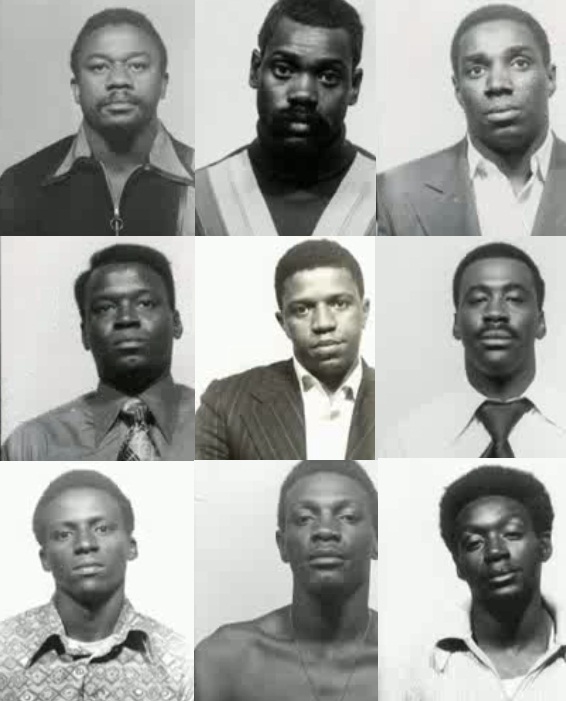 The Black Mafia, also known as the Muslim Mafia or Muslim Mob, is a Philadelphia-based African-American organized crime syndicate. The organization began as a small criminal collective, known for holding up neighborhood crap games and dealing in the illegal drug business, but at its height of operation until about 1975, it managed to consolidate power and control a large portion of criminal activity in various African-American neighborhoods throughout Philadelphia, the Delaware Valley, and South Jersey, including Atlantic City. In addition to drug trafficking, burglary, and armed robbery, the Black Mafia was also engaged in traditional organized crime activities such as extortion, racketeering, number running, illegal gambling, and prostitution.
The Black Mafia, also known as the Muslim Mafia or Muslim Mob, is a Philadelphia-based African-American organized crime syndicate. The organization began as a small criminal collective, known for holding up neighborhood crap games and dealing in the illegal drug business, but at its height of operation until about 1975, it managed to consolidate power and control a large portion of criminal activity in various African-American neighborhoods throughout Philadelphia, the Delaware Valley, and South Jersey, including Atlantic City. In addition to drug trafficking, burglary, and armed robbery, the Black Mafia was also engaged in traditional organized crime activities such as extortion, racketeering, number running, illegal gambling, and prostitution.
 Allegedly formed in September 1968 by Samuel Christian, (left) who later adopted the name Suleiman Bey under the Nation of Islam, the Black Mafia was heavily involved in a large part of drug trafficking in Philadelphia during the 1970s, with heroin being the most trafficked drug. Christian, a former Black Panther with an extensive arrest record, was an imposing man: 5'10' tall and described as a "thick-necked, 215-pound bully." Additional founding members included Ronald Harvey, Henry Dabney, Richard "Pork Chops" James, Donald "Donnie" Day, Clyde "Apples" Ross, Robert "Bop Daddy" Fairbanks, Craig "Heist" Jones, Walter Hudgins, Robert "Nudie" Mims amongst others. Nearly all of the original members eventually became Nation of Islam members or converted to Islam, giving the organization the nickname of "the Muslim Mafia" or "the Muslim Mob."
Allegedly formed in September 1968 by Samuel Christian, (left) who later adopted the name Suleiman Bey under the Nation of Islam, the Black Mafia was heavily involved in a large part of drug trafficking in Philadelphia during the 1970s, with heroin being the most trafficked drug. Christian, a former Black Panther with an extensive arrest record, was an imposing man: 5'10' tall and described as a "thick-necked, 215-pound bully." Additional founding members included Ronald Harvey, Henry Dabney, Richard "Pork Chops" James, Donald "Donnie" Day, Clyde "Apples" Ross, Robert "Bop Daddy" Fairbanks, Craig "Heist" Jones, Walter Hudgins, Robert "Nudie" Mims amongst others. Nearly all of the original members eventually became Nation of Islam members or converted to Islam, giving the organization the nickname of "the Muslim Mafia" or "the Muslim Mob."
The Black Mafia gained power in local neighborhoods by intimidating people to prevent anyone from reporting the group's activities to the police. Because of this, police had incredible difficulty taking any action on the gang or any of its members for years after their conception. Members participated in holding up crap games and extorting drug dealers, working as numbers men and illegitimate businessmen. Over the course of their control, the Black Mafia was responsible for over 40 murders and countless other crimes. Each founder had extensive arrest records, with most cases involving violence. Law enforcement officials had difficulties prosecuting members of the group, however, because witnesses would rarely cooperate, fearing retaliation, and cases were dropped more often than not. This not only permitted the offenders to continue their criminal activities, but also allowed their reputations of being "untouchable" to flourish, thus enhancing their influence on the street.
THE NEW FACE OF THE JEWISH MOB
Sylvan "Cherry Hill Fats" Scolnick
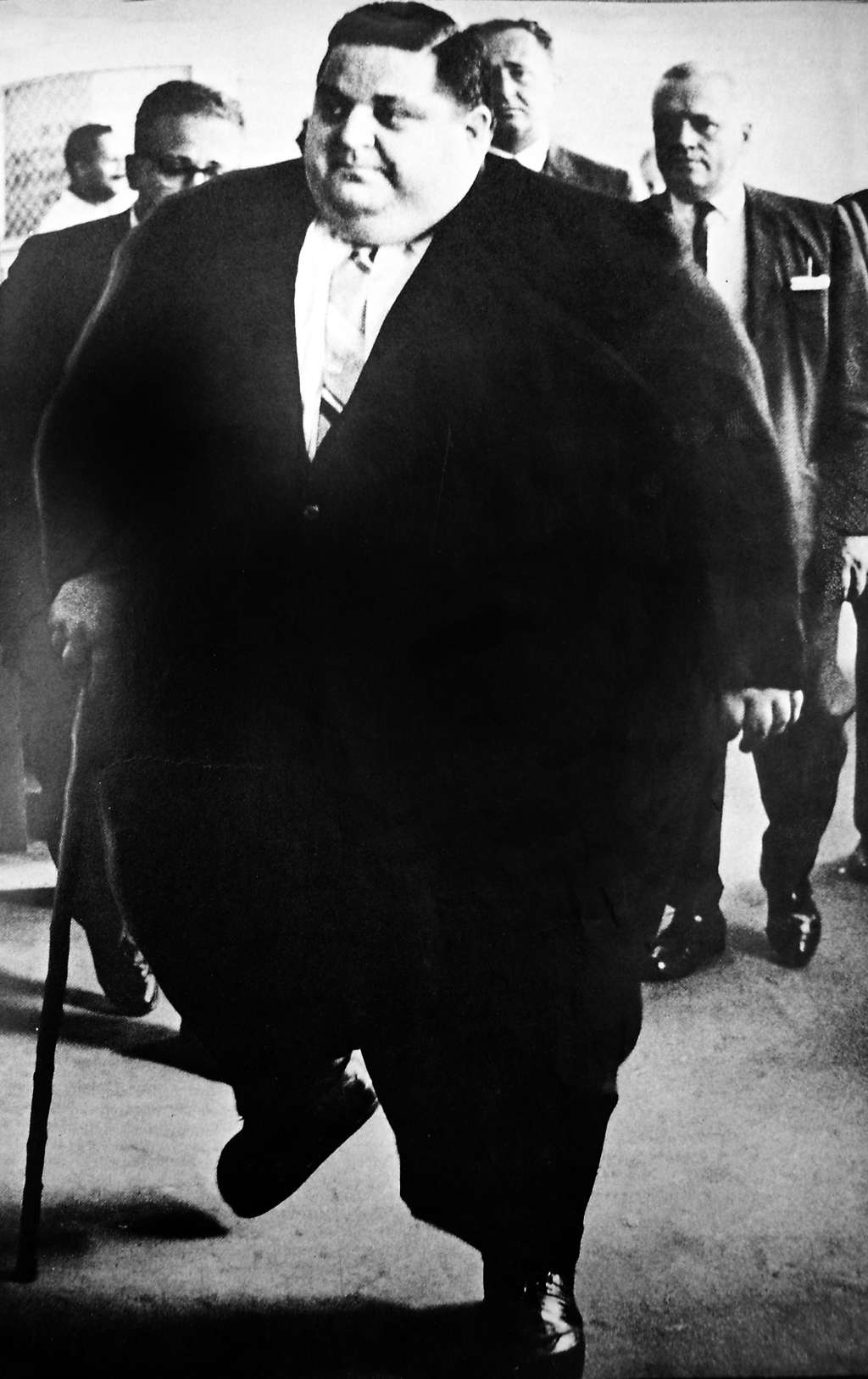
Cherry Hill Fats was worth his weight in criminal intelligence. Topping 700 lbs wolfing down plates of food at his daily haunt the Haddonfield diner Scolnick would mastermind some of the best criminal plans known. His crew consisted of Hebrew wiseguys like Sid Brooks (right), George Bricker (left), Irv Singer, Kenny Paul, and Allen Rosenberg. Sid Brooks Philadelphia night club owner came to Scolnick with an IRS problem in which the fat brain concocted a scheme that made front page news. 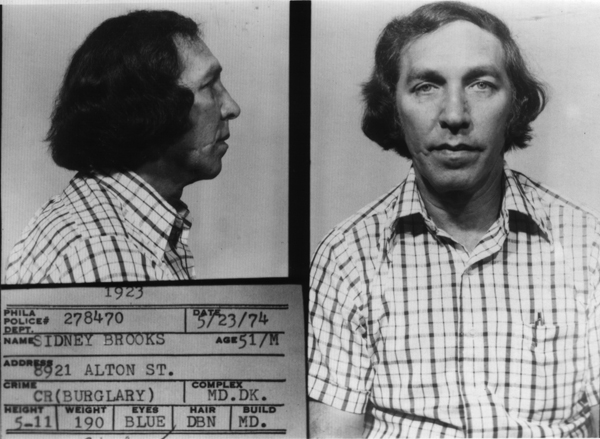
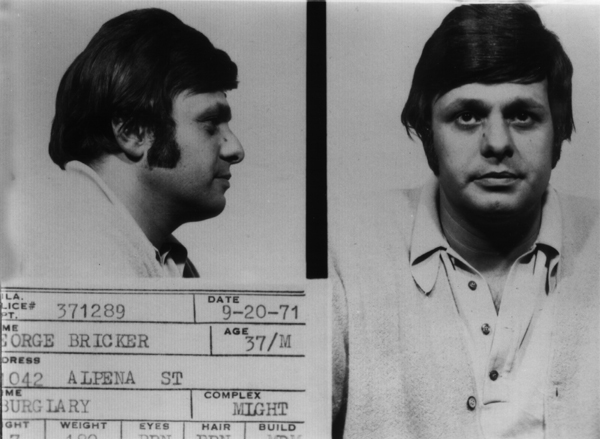 Seems Brooks was skimming of the gross profits from his club and stashing the cash in a safe deposit box in a Cottman avenue bank. The IRS got wind of the skimming and sealed the box. On a visit to the bank Brooks found the box sealed and was furious, going to Scolnick complaining and needing his advice. Scolnick devised a plan to smash a brick through the large window, while another gangster planted inside "yelled it's a bomb get down!". Another mob member would get the master teller key while the commotion was going on and get the box. The plan would have worked if the mobster with the key would have closed and locked the box door, but he left it opened. It didn't take the investigators long to put two and two together. Another of Scolnicks members came to him complaining he got a truck load of paint, but it's not good paint, and he can't unload it. Scolnick told his man to go and get a gallon of good Dupont paint and take it to a printer friend of his and duplicate the label. That plan would have succeeded also if the stupid gangster wouldn't have talked to much about himself and his associates. It turned out the professional painters new immediately the paint was of very poor quality as soon as they started to use it. George Bricker was the down fall of the gang when he crumbled while being questioned intensely by law enforcement, earning him the moniker 'the singing burglar' Sid Brooks continued on with his criminal career after loosing his gin joint, and became a practitioner of Jewish lightning. Scolnick would die of his obesity, and Singer would go to jail for butchering his wife for screwing south Philly wiseguys.
Seems Brooks was skimming of the gross profits from his club and stashing the cash in a safe deposit box in a Cottman avenue bank. The IRS got wind of the skimming and sealed the box. On a visit to the bank Brooks found the box sealed and was furious, going to Scolnick complaining and needing his advice. Scolnick devised a plan to smash a brick through the large window, while another gangster planted inside "yelled it's a bomb get down!". Another mob member would get the master teller key while the commotion was going on and get the box. The plan would have worked if the mobster with the key would have closed and locked the box door, but he left it opened. It didn't take the investigators long to put two and two together. Another of Scolnicks members came to him complaining he got a truck load of paint, but it's not good paint, and he can't unload it. Scolnick told his man to go and get a gallon of good Dupont paint and take it to a printer friend of his and duplicate the label. That plan would have succeeded also if the stupid gangster wouldn't have talked to much about himself and his associates. It turned out the professional painters new immediately the paint was of very poor quality as soon as they started to use it. George Bricker was the down fall of the gang when he crumbled while being questioned intensely by law enforcement, earning him the moniker 'the singing burglar' Sid Brooks continued on with his criminal career after loosing his gin joint, and became a practitioner of Jewish lightning. Scolnick would die of his obesity, and Singer would go to jail for butchering his wife for screwing south Philly wiseguys.


 The Killers (left) were among the first of a group of Philly gangsters strictly born of ethnicity. Scott and English Activist gangs during the 17th century, organized themselves under the cover of Volunteer Firemen. Historians have identified 50 such violent Philadelphia street gangs during the era with such colorful names as the Blood Tubs, the Schuylkill Rangers, the Neckers and the Snappers. The gangs fought each other and often attacked innocent citizens on the streets.In the summer of 1844 nativist gangs roamed the streets of Philadelphia and it's then surrounding Burroughs Kensington not yet consolidated into the city looking to destroy everything they could having to do with the Irish. To the shame of the entire young country, they did the unthinkable, They burnt Saint Michael's Catholic church to the ground. Newspapers throughout the world reported the burning. The City of Brotherly love received a black eye that took decades to recover from. Other churches were also the the victim of Irish hate. Jews, Blacks and anyone else who didn't have English Scott blood running through their vain's were not Americans, and unwelcome. American Indians were even worse off. They were being driven out of the future land of the free to reservations. But soon other ethnic groups would arrive and organize into an underworld of secret societies, as in the secret society of the Irish Molly Maguire's. The Molly Maguire's was an Irish 19th century secret society active in Ireland, Liverpool and parts of the eastern United States, best known for their activism among Irish American and Irish immigrant coal miners in Pennsylvania. After a series of often violent conflicts, twenty suspected members of the Molly Maguire's were convicted of murder and other crimes and were executed by hanging in 1877 and 1878. They having the longest history in organized crime and the world of gangsters held strong in their tenacious clannish ways.
The Killers (left) were among the first of a group of Philly gangsters strictly born of ethnicity. Scott and English Activist gangs during the 17th century, organized themselves under the cover of Volunteer Firemen. Historians have identified 50 such violent Philadelphia street gangs during the era with such colorful names as the Blood Tubs, the Schuylkill Rangers, the Neckers and the Snappers. The gangs fought each other and often attacked innocent citizens on the streets.In the summer of 1844 nativist gangs roamed the streets of Philadelphia and it's then surrounding Burroughs Kensington not yet consolidated into the city looking to destroy everything they could having to do with the Irish. To the shame of the entire young country, they did the unthinkable, They burnt Saint Michael's Catholic church to the ground. Newspapers throughout the world reported the burning. The City of Brotherly love received a black eye that took decades to recover from. Other churches were also the the victim of Irish hate. Jews, Blacks and anyone else who didn't have English Scott blood running through their vain's were not Americans, and unwelcome. American Indians were even worse off. They were being driven out of the future land of the free to reservations. But soon other ethnic groups would arrive and organize into an underworld of secret societies, as in the secret society of the Irish Molly Maguire's. The Molly Maguire's was an Irish 19th century secret society active in Ireland, Liverpool and parts of the eastern United States, best known for their activism among Irish American and Irish immigrant coal miners in Pennsylvania. After a series of often violent conflicts, twenty suspected members of the Molly Maguire's were convicted of murder and other crimes and were executed by hanging in 1877 and 1878. They having the longest history in organized crime and the world of gangsters held strong in their tenacious clannish ways.  The Tongs originated as Chinese Benevolent Associations on the west coast of the United States during the Gold Rush era. Although believed to be offshoots of the Triads, they were formed primarily as a means of protection from white racists who periodically raided "Chinatown" areas. Anti-Chinese riots were common in the late 1800's, especially in San Francisco and New York City. It was not unusual, for instance, for groups of Chinese to be murdered while local authorities remained indifferent.
The Tongs originated as Chinese Benevolent Associations on the west coast of the United States during the Gold Rush era. Although believed to be offshoots of the Triads, they were formed primarily as a means of protection from white racists who periodically raided "Chinatown" areas. Anti-Chinese riots were common in the late 1800's, especially in San Francisco and New York City. It was not unusual, for instance, for groups of Chinese to be murdered while local authorities remained indifferent. Philadelphia's first Black Hand Haunt (left). The cities Inquire news paper headlines read " Police say they have unearthed Mafia Haunt in - Little
Philadelphia's first Black Hand Haunt (left). The cities Inquire news paper headlines read " Police say they have unearthed Mafia Haunt in - Little Italy. In the rear of 808 Catherine street in the city's south Philadelphia section. Police claim they have located a branch of the Italians secret Society. A resident claims he was threatened with violence, unless he paid money. The "x" indicates the exact location of the raid. This Black Hand extortion note (right) translates "We want $2,500.00 under penalty of death to himself and family, BLACK HAND.
Italy. In the rear of 808 Catherine street in the city's south Philadelphia section. Police claim they have located a branch of the Italians secret Society. A resident claims he was threatened with violence, unless he paid money. The "x" indicates the exact location of the raid. This Black Hand extortion note (right) translates "We want $2,500.00 under penalty of death to himself and family, BLACK HAND. This Philly Newspaper photo (left) was the seen of a Black Hand Bombing. Located at 907 ,909 S. 9th St. according to the proprietors Mr. Volpe and Marstae they received a demand note weeks before demanding money from the Black Hand. Although State and local cops couldn't prove a an organized society at the time. The Black Handers were common knowledge to Italians. By the time of the Black Hand Philadelphia absorbed several surrounding burroughs enabling law enforcement more lead way in enforcing the law., but the secrecy of Omerta was something the cops were unable to break, nor understand. The Philadelphia Police started to recruit Italians to the mainly Irish force, but that was a internal war all it's own. Italians were untrusted by their peers.
This Philly Newspaper photo (left) was the seen of a Black Hand Bombing. Located at 907 ,909 S. 9th St. according to the proprietors Mr. Volpe and Marstae they received a demand note weeks before demanding money from the Black Hand. Although State and local cops couldn't prove a an organized society at the time. The Black Handers were common knowledge to Italians. By the time of the Black Hand Philadelphia absorbed several surrounding burroughs enabling law enforcement more lead way in enforcing the law., but the secrecy of Omerta was something the cops were unable to break, nor understand. The Philadelphia Police started to recruit Italians to the mainly Irish force, but that was a internal war all it's own. Italians were untrusted by their peers.
 Savatore Sabella tries to snuff out the competition by attempting to rub out the Zanghi brothers, Musky and Joseph, along with Scabby Cocozza, but succeeds only in
Savatore Sabella tries to snuff out the competition by attempting to rub out the Zanghi brothers, Musky and Joseph, along with Scabby Cocozza, but succeeds only in killing Joseph and Scabby. Sabella along with his gang, John Avena, Antonio Pillina, with John Scopoletti behind the wheel, drove off, after the mob hit. Musky Zanghi the actual target of the hit survived and became the mobs first rat. The newspapers headlines banner “The Underworld’s First Squealer”.
killing Joseph and Scabby. Sabella along with his gang, John Avena, Antonio Pillina, with John Scopoletti behind the wheel, drove off, after the mob hit. Musky Zanghi the actual target of the hit survived and became the mobs first rat. The newspapers headlines banner “The Underworld’s First Squealer”.
 Jonathan Saint Claire AKA West Indian Johnny (pictured left). A gambler from the Caribbean immigrated to Philadelphia in the
Jonathan Saint Claire AKA West Indian Johnny (pictured left). A gambler from the Caribbean immigrated to Philadelphia in the early 19th century. He introduced the numbers racket to the entire east coast, for a penny you would get $4.00, for a nickel you got $22.50, and for a dime you would get $44.00. The three numbers were based on the last three numbers sold on the Stock Exchange. Forrest White Woodard came to Philadelphia from Virginia 1898 (pictured right) by 1922 he was running the biggest numbers operation in the city. By 1930 he became the richest Black man in Philly. The Following year he and the Black Numbers racket was taken over by violent Italian and Jewish Gangsters, headed by the notorious Lanzetti Brothers, the numbers racket was absorbed by the Lanzetti's and Woodard Retired into Legitimate a business. Philadelphia Blacks were forced out of the City wide syndicates. They were reduced running there own neighborhood book and betting parlors. Black book makers and racketeers became the backers for black business and churches who couldn't get loans from white banks. Actor Delroy Lindo in his portrayal of the bipolar numbers boss West Indian Archie in Spike Lee's Malcolm X is actually believed to be Jonathan Saint Claire AKA West Indian Johnny from Philadelphia, but artistic license was taken because the movie is set in New York.
early 19th century. He introduced the numbers racket to the entire east coast, for a penny you would get $4.00, for a nickel you got $22.50, and for a dime you would get $44.00. The three numbers were based on the last three numbers sold on the Stock Exchange. Forrest White Woodard came to Philadelphia from Virginia 1898 (pictured right) by 1922 he was running the biggest numbers operation in the city. By 1930 he became the richest Black man in Philly. The Following year he and the Black Numbers racket was taken over by violent Italian and Jewish Gangsters, headed by the notorious Lanzetti Brothers, the numbers racket was absorbed by the Lanzetti's and Woodard Retired into Legitimate a business. Philadelphia Blacks were forced out of the City wide syndicates. They were reduced running there own neighborhood book and betting parlors. Black book makers and racketeers became the backers for black business and churches who couldn't get loans from white banks. Actor Delroy Lindo in his portrayal of the bipolar numbers boss West Indian Archie in Spike Lee's Malcolm X is actually believed to be Jonathan Saint Claire AKA West Indian Johnny from Philadelphia, but artistic license was taken because the movie is set in New York.








 Harry "Nig" Rosen (left) was a Philadelphia mobster who was a major organized crime figure on the east coast with influence as far as Atlantic City, Baltimore and Washington, DC. Born Harry Stromberg, Rosen emerged as a prominent racketeer in southeast Philadelphia and, as head of the 69th Street Gang, became involved prostitution, extortion, labor racketeering and later in narcotics with Arnold Rothstein during the mid-1920s. Succeeding Max "Boo Hoo" Hoff as the cities chief bootlegger during Prohibition, he was a member of the "Big Seven" aligned with the Philadelphia faction along with Waxy Gordon and Irving Blitz, later attending the Atlantic City Conference. During the 1930s, he and Lansky worked on expanding drug trafficking operations in Mexico as an alternative to older routes such as Japan now closed with United States entry into the Second World War. By 1939, a lucrative heroin network had been established from drug traffickers based in Mexico City to major cities across the United States including New York, Philadelphia, Miami and Los Angeles as well as Havana, Cuba. He and his lieutenant, driver and bodyguard William "Willie" Weisberg, were named as dominant racketeers involved in the numbers racket under testimony from police superintendent George F. Richardson during the Kefauver Committee in 1951.
Harry "Nig" Rosen (left) was a Philadelphia mobster who was a major organized crime figure on the east coast with influence as far as Atlantic City, Baltimore and Washington, DC. Born Harry Stromberg, Rosen emerged as a prominent racketeer in southeast Philadelphia and, as head of the 69th Street Gang, became involved prostitution, extortion, labor racketeering and later in narcotics with Arnold Rothstein during the mid-1920s. Succeeding Max "Boo Hoo" Hoff as the cities chief bootlegger during Prohibition, he was a member of the "Big Seven" aligned with the Philadelphia faction along with Waxy Gordon and Irving Blitz, later attending the Atlantic City Conference. During the 1930s, he and Lansky worked on expanding drug trafficking operations in Mexico as an alternative to older routes such as Japan now closed with United States entry into the Second World War. By 1939, a lucrative heroin network had been established from drug traffickers based in Mexico City to major cities across the United States including New York, Philadelphia, Miami and Los Angeles as well as Havana, Cuba. He and his lieutenant, driver and bodyguard William "Willie" Weisberg, were named as dominant racketeers involved in the numbers racket under testimony from police superintendent George F. Richardson during the Kefauver Committee in 1951.

, Martin Martinson, Abraham Goldberg, Jack Feldman, Irving Blitz, and Edward Kane, Emilio Strollo behind Kane..jpg)

 Duffy was named either Michael or William at birth in the Grays Ferry district of Philadelphia sometime around 1888. Mickey was arrested for the first time in 1908, which would actually make him 20. Duffy was sent up in May 1919 for assault and battery with intent to kill. He served almost three years at Philadelphia’s Eastern State Penitentiary, where Al Capone would also sit out the St. Valentine’s Day Massacre. When Mickey got out, he was released into the world of Prohibition. He got married to Edith Craig and opened up his own bootleg operations. He started with smuggling booze into Philadelphia, but soon began brewing it himself.
Duffy was named either Michael or William at birth in the Grays Ferry district of Philadelphia sometime around 1888. Mickey was arrested for the first time in 1908, which would actually make him 20. Duffy was sent up in May 1919 for assault and battery with intent to kill. He served almost three years at Philadelphia’s Eastern State Penitentiary, where Al Capone would also sit out the St. Valentine’s Day Massacre. When Mickey got out, he was released into the world of Prohibition. He got married to Edith Craig and opened up his own bootleg operations. He started with smuggling booze into Philadelphia, but soon began brewing it himself.
 .
.

 escalation of a wave of periodic violence among many competing bootlegging gangs. The killings touched off the 1928 Special August Grand Jury, which received national attention when it detailed the extent of corruption and bootleggers power in Philadelphia, but produced little in the way of successful indictments.
escalation of a wave of periodic violence among many competing bootlegging gangs. The killings touched off the 1928 Special August Grand Jury, which received national attention when it detailed the extent of corruption and bootleggers power in Philadelphia, but produced little in the way of successful indictments. Scarface as he was called, but not his face. Was summoned as all the mob bosses were to Atlantic City. Seems Al's Saint Valentines Massacre was getting ugly with law enforcement and the public. The story goes, he was told to get pinched with gun in Philly and lay low in a Quaker built pinched called Eastern State Penitentiary for a year. The fix was in and Scareface was arrested for carrying a concealed, deadly weapon, this was Capone’s first prison sentence, so the sentence was light for the standards at that time. Chicago’s most famous mob boss spent eight months at Eastern State in 1929-1930. Alphonse's time in Eastern State was spent in relative luxury. His cell on the Park Avenue Block had fine furniture, oriental rugs, and a cabinet radio (pictured right).
Scarface as he was called, but not his face. Was summoned as all the mob bosses were to Atlantic City. Seems Al's Saint Valentines Massacre was getting ugly with law enforcement and the public. The story goes, he was told to get pinched with gun in Philly and lay low in a Quaker built pinched called Eastern State Penitentiary for a year. The fix was in and Scareface was arrested for carrying a concealed, deadly weapon, this was Capone’s first prison sentence, so the sentence was light for the standards at that time. Chicago’s most famous mob boss spent eight months at Eastern State in 1929-1930. Alphonse's time in Eastern State was spent in relative luxury. His cell on the Park Avenue Block had fine furniture, oriental rugs, and a cabinet radio (pictured right).
 Philadelphia like every other city's law enforcement in America was busy hunting for spies and other groups trying to circumvent the war effort, and the mob was enlisted to help. Many Italian mobsters had ties to Italy and Sicily's illicit underground, and the need for information on Mussolini's Italy was crucial. The Japanese being interned was no threat. Although the German American bund was a serious threat to the countries war effort. The photograph (left) shows a meeting of the Bund at a local German club at 6th and Erie avenue just before the war. Once war was declared the Bund and Nazi sympathizers had to take their activity underground. Active in Philadelphia the Bund surveillance needed a lot of man power, leaving the gangsters at the time of the war abel to run their illegal enterprises easier. As the war ended the economy was booming. Booze was legal and jobs were plentiful, but vices were still in demand.
Philadelphia like every other city's law enforcement in America was busy hunting for spies and other groups trying to circumvent the war effort, and the mob was enlisted to help. Many Italian mobsters had ties to Italy and Sicily's illicit underground, and the need for information on Mussolini's Italy was crucial. The Japanese being interned was no threat. Although the German American bund was a serious threat to the countries war effort. The photograph (left) shows a meeting of the Bund at a local German club at 6th and Erie avenue just before the war. Once war was declared the Bund and Nazi sympathizers had to take their activity underground. Active in Philadelphia the Bund surveillance needed a lot of man power, leaving the gangsters at the time of the war abel to run their illegal enterprises easier. As the war ended the economy was booming. Booze was legal and jobs were plentiful, but vices were still in demand. in this city." The Green Street Counts were active in the early 1950s. About the same time (early to mid-1950s) another group of teenagers in Philadelphia took the name Green Street Counts (West). This group of teenagers led by Carlos were operating in a West Philadelphia neighborhood extending from 38th to 47th Streets and Walnut Street to Woodland Avenue. The Green Street Counts (West) were not affiliated with the original Green Street Counts.
in this city." The Green Street Counts were active in the early 1950s. About the same time (early to mid-1950s) another group of teenagers in Philadelphia took the name Green Street Counts (West). This group of teenagers led by Carlos were operating in a West Philadelphia neighborhood extending from 38th to 47th Streets and Walnut Street to Woodland Avenue. The Green Street Counts (West) were not affiliated with the original Green Street Counts.



 The only problem was a tough as nails Philadelphia Irishman, and K&A gang associate had his sights on the AC casino construction business as well. John McCullough a beloved union leader of Roofers local 30 B was planning his entrance to the Atlantic City enterprise. Immediately he began union organizing. The Bartenders, housekeepers, restaurant workers and security guards were being called to unionize. But Little Nicky Scarfo wasn't hearing any of that stuff. McCullough along with a loyal union following, also had very close ties to the Irish K&A gang.
The only problem was a tough as nails Philadelphia Irishman, and K&A gang associate had his sights on the AC casino construction business as well. John McCullough a beloved union leader of Roofers local 30 B was planning his entrance to the Atlantic City enterprise. Immediately he began union organizing. The Bartenders, housekeepers, restaurant workers and security guards were being called to unionize. But Little Nicky Scarfo wasn't hearing any of that stuff. McCullough along with a loyal union following, also had very close ties to the Irish K&A gang.  high school dropouts named Effie Burke and Willie Sears pictured (right) sometime near the end of the 1950s they engineered a system of burglary called production work.The two gangsters recruited many of high school drop outs from the Kensington area of the city. Jimmy Dolan, Jackie Johnson, John Berkery, Hughy Breslin, Herman Cable, Junior Kripplebauer, Chickie Goodroe and many more. Unlike the Mafia, The K&A gang known as an Irish gang ran the gambit of Irish, Jews, Italians, Polish and German. Their was was no organized commission, and as time went on, the gang grew into many small crews with no single leader. Freelancing was accepted, but the code of silence was the same as the La Costa Nostra. Police and FBI called them the best burglars in the country. The Woolworth, Dupont families, a State Governor and hundreds of very wealthy capitalists fell victim to their craft. Jewish store owners from the more affluent section of the city were constantly being burgled from the gang. Seems these uneducated hoodlums realized Jewish store owners do their best business on the weekends. As the store owner left with the days profits in cash, the gang would follow them home, then burgle them when they went to the synagogue. You see the banks weren't open on weekends, so we knew the money was in the empty house, said one gangster. The Gang had one rule no guns. If a gun was found during the caper, it was tossed in the toilet water closet and made inoperable. As the years passed on and the gang grew, it got so bad that the police started printing multi page booklets with the gangsters photographs hangouts and associates. Every cop in the area the gang hung out carried those books. Below is a very small sample of K&A gangsters from the pages of those books, but their are over a hundred of them, and shows just how many of these gangster practitioners of production work their were throughout the Kensington section.
high school dropouts named Effie Burke and Willie Sears pictured (right) sometime near the end of the 1950s they engineered a system of burglary called production work.The two gangsters recruited many of high school drop outs from the Kensington area of the city. Jimmy Dolan, Jackie Johnson, John Berkery, Hughy Breslin, Herman Cable, Junior Kripplebauer, Chickie Goodroe and many more. Unlike the Mafia, The K&A gang known as an Irish gang ran the gambit of Irish, Jews, Italians, Polish and German. Their was was no organized commission, and as time went on, the gang grew into many small crews with no single leader. Freelancing was accepted, but the code of silence was the same as the La Costa Nostra. Police and FBI called them the best burglars in the country. The Woolworth, Dupont families, a State Governor and hundreds of very wealthy capitalists fell victim to their craft. Jewish store owners from the more affluent section of the city were constantly being burgled from the gang. Seems these uneducated hoodlums realized Jewish store owners do their best business on the weekends. As the store owner left with the days profits in cash, the gang would follow them home, then burgle them when they went to the synagogue. You see the banks weren't open on weekends, so we knew the money was in the empty house, said one gangster. The Gang had one rule no guns. If a gun was found during the caper, it was tossed in the toilet water closet and made inoperable. As the years passed on and the gang grew, it got so bad that the police started printing multi page booklets with the gangsters photographs hangouts and associates. Every cop in the area the gang hung out carried those books. Below is a very small sample of K&A gangsters from the pages of those books, but their are over a hundred of them, and shows just how many of these gangster practitioners of production work their were throughout the Kensington section.




 demand in the area. By the early 1980s, John Carlyle Berkery had close ties with Angelo Bruno and Raymond "Long John" Martorano of the Philadelphia crime family. It was through these influential connections that the K&A Gang would expand into other rackets establishing its foothold in the Northeast. In 1983, Philadelphia garnered a reputation as the "meth capital of the world", according to a statement published by the Associated Press, from a local police officer. It is widely held that this was made possible due to the K&A Gang, and the Junior Black Mafia, Outlaw Biker gangs among others. After being indicted for 14 counts of trafficking in methamphetamine and the chemical P2P in January 1982, Berkery fled to Ireland to avoid prosecution.. In the fall of 1987, after spending five years on the run, he was captured in June 1987 and subsequently faced trial. Berkery admitted to engaging in a large scale meth deal with Chelsais Bouras, leader of the Philadelphia Greek Mob. Ronald Raiton, a notable criminal figure in the methamphetamine trade, testified that Berkery had bought 200 gallons of P2P from Raiton over the course of a year in 1980-1981. Prosecutors stated that he and Raymond Martorano (left) had planned to take over all meth trafficking in Philadelphia. Carl "Better Days" Jackson assumed control of the group. Jackson went on to lead the group until his conviction in late 1987, just a week after his former boss faced trial and was also found guilty. Jackson was said to have gained around 4 million dollars in drug profits in the period between his takeover of the gang's meth endeavors and his eventual arrest. He received a lifetime sentence in accordance with the Continuing Criminal Enterprise statute, otherwise known as the "drug kingpin" law. Along with Carl Jackson, 22 affiliates of the K&A meth ring were indicted under federal drug manufacturing charges related to an operation that authorities believe produced roughly ten million dollars worth of speed in hidden labs in the across Pennsylvania area. They were said to have manufactured 100 pounds of methamphetamine at a time, which was then distributed by Jackson's subordinates. At the time US Attorney Edward Dennis claimed in a press release that the gang is "one of the largest methamphetamine organizations in the
demand in the area. By the early 1980s, John Carlyle Berkery had close ties with Angelo Bruno and Raymond "Long John" Martorano of the Philadelphia crime family. It was through these influential connections that the K&A Gang would expand into other rackets establishing its foothold in the Northeast. In 1983, Philadelphia garnered a reputation as the "meth capital of the world", according to a statement published by the Associated Press, from a local police officer. It is widely held that this was made possible due to the K&A Gang, and the Junior Black Mafia, Outlaw Biker gangs among others. After being indicted for 14 counts of trafficking in methamphetamine and the chemical P2P in January 1982, Berkery fled to Ireland to avoid prosecution.. In the fall of 1987, after spending five years on the run, he was captured in June 1987 and subsequently faced trial. Berkery admitted to engaging in a large scale meth deal with Chelsais Bouras, leader of the Philadelphia Greek Mob. Ronald Raiton, a notable criminal figure in the methamphetamine trade, testified that Berkery had bought 200 gallons of P2P from Raiton over the course of a year in 1980-1981. Prosecutors stated that he and Raymond Martorano (left) had planned to take over all meth trafficking in Philadelphia. Carl "Better Days" Jackson assumed control of the group. Jackson went on to lead the group until his conviction in late 1987, just a week after his former boss faced trial and was also found guilty. Jackson was said to have gained around 4 million dollars in drug profits in the period between his takeover of the gang's meth endeavors and his eventual arrest. He received a lifetime sentence in accordance with the Continuing Criminal Enterprise statute, otherwise known as the "drug kingpin" law. Along with Carl Jackson, 22 affiliates of the K&A meth ring were indicted under federal drug manufacturing charges related to an operation that authorities believe produced roughly ten million dollars worth of speed in hidden labs in the across Pennsylvania area. They were said to have manufactured 100 pounds of methamphetamine at a time, which was then distributed by Jackson's subordinates. At the time US Attorney Edward Dennis claimed in a press release that the gang is "one of the largest methamphetamine organizations in the  nation." Edward Loney (left - and still a fugitive believed to be living in Ireland) was to have arranged the obtaining of 50 gallons of P2P, a precursor chemical, along with Waldemar "Walter" Roeder from Toronto,
nation." Edward Loney (left - and still a fugitive believed to be living in Ireland) was to have arranged the obtaining of 50 gallons of P2P, a precursor chemical, along with Waldemar "Walter" Roeder from Toronto,  while Jackson sold mass quantities to contacts in New York. After the downfall of Carl Jackson, Roy Stocker (right) became the dominant K&A member operating a methamphetamine manufacturing enterprise. In 1981, Stacker sought a partnership with Scarfo in an methamphetamine operation in Northeast Philadelphia, through Albert "Reds" Pontani. Between 1981 and 1986 he allegedly produced and distributed methamphetamine, commonly known as speed, and also allegedly took part in extortion, loan-sharking and burglary. The meth rings were sanctioned by the Scarfo crime family, who received a cut of the profits. In February 1991, Roy Stocker and three others were found guilty of operating a ring that sold $52 million worth of methamphetamine between 1981 and 1987.
while Jackson sold mass quantities to contacts in New York. After the downfall of Carl Jackson, Roy Stocker (right) became the dominant K&A member operating a methamphetamine manufacturing enterprise. In 1981, Stacker sought a partnership with Scarfo in an methamphetamine operation in Northeast Philadelphia, through Albert "Reds" Pontani. Between 1981 and 1986 he allegedly produced and distributed methamphetamine, commonly known as speed, and also allegedly took part in extortion, loan-sharking and burglary. The meth rings were sanctioned by the Scarfo crime family, who received a cut of the profits. In February 1991, Roy Stocker and three others were found guilty of operating a ring that sold $52 million worth of methamphetamine between 1981 and 1987. The Black Mafia, also known as the Muslim Mafia or Muslim Mob, is a Philadelphia-based African-American organized crime syndicate. The organization began as a small criminal collective, known for holding up neighborhood crap games and dealing in the illegal drug business, but at its height of operation until about 1975, it managed to consolidate power and control a large portion of criminal activity in various African-American neighborhoods throughout Philadelphia, the Delaware Valley, and South Jersey, including Atlantic City. In addition to drug trafficking, burglary, and armed robbery, the Black Mafia was also engaged in traditional organized crime activities such as extortion, racketeering, number running, illegal gambling, and prostitution.
The Black Mafia, also known as the Muslim Mafia or Muslim Mob, is a Philadelphia-based African-American organized crime syndicate. The organization began as a small criminal collective, known for holding up neighborhood crap games and dealing in the illegal drug business, but at its height of operation until about 1975, it managed to consolidate power and control a large portion of criminal activity in various African-American neighborhoods throughout Philadelphia, the Delaware Valley, and South Jersey, including Atlantic City. In addition to drug trafficking, burglary, and armed robbery, the Black Mafia was also engaged in traditional organized crime activities such as extortion, racketeering, number running, illegal gambling, and prostitution. Allegedly formed in September 1968 by Samuel Christian, (left) who later adopted the name Suleiman Bey under the Nation of Islam, the Black Mafia was heavily involved in a large part of drug trafficking in Philadelphia during the 1970s, with heroin being the most trafficked drug. Christian, a former Black Panther with an extensive arrest record, was an imposing man: 5'10' tall and described as a "thick-necked, 215-pound bully." Additional founding members included Ronald Harvey, Henry Dabney, Richard "Pork Chops" James, Donald "Donnie" Day, Clyde "Apples" Ross, Robert "Bop Daddy" Fairbanks, Craig "Heist" Jones, Walter Hudgins, Robert "Nudie" Mims amongst others. Nearly all of the original members eventually became Nation of Islam members or converted to Islam, giving the organization the nickname of "the Muslim Mafia" or "the Muslim Mob."
Allegedly formed in September 1968 by Samuel Christian, (left) who later adopted the name Suleiman Bey under the Nation of Islam, the Black Mafia was heavily involved in a large part of drug trafficking in Philadelphia during the 1970s, with heroin being the most trafficked drug. Christian, a former Black Panther with an extensive arrest record, was an imposing man: 5'10' tall and described as a "thick-necked, 215-pound bully." Additional founding members included Ronald Harvey, Henry Dabney, Richard "Pork Chops" James, Donald "Donnie" Day, Clyde "Apples" Ross, Robert "Bop Daddy" Fairbanks, Craig "Heist" Jones, Walter Hudgins, Robert "Nudie" Mims amongst others. Nearly all of the original members eventually became Nation of Islam members or converted to Islam, giving the organization the nickname of "the Muslim Mafia" or "the Muslim Mob."
 Seems Brooks was skimming of the gross profits from his club and stashing the cash in a safe deposit box in a Cottman avenue bank. The IRS got wind of the skimming and sealed the box. On a visit to the bank Brooks found the box sealed and was furious, going to Scolnick complaining and needing his advice. Scolnick devised a plan to smash a brick through the large window, while another gangster planted inside "yelled it's a bomb get down!". Another mob member would get the master teller key while the commotion was going on and get the box. The plan would have worked if the mobster with the key would have closed and locked the box door, but he left it opened. It didn't take the investigators long to put two and two together. Another of Scolnicks members came to him complaining he got a truck load of paint, but it's not good paint, and he can't unload it. Scolnick told his man to go and get a gallon of good Dupont paint and take it to a printer friend of his and duplicate the label. That plan would have succeeded also if the stupid gangster wouldn't have talked to much about himself and his associates. It turned out the professional painters new immediately the paint was of very poor quality as soon as they started to use it. George Bricker was the down fall of the gang when he crumbled while being questioned intensely by law enforcement, earning him the moniker 'the singing burglar' Sid Brooks continued on with his criminal career after loosing his gin joint, and became a practitioner of Jewish lightning. Scolnick would die of his obesity, and Singer would go to jail for butchering his wife for screwing south Philly wiseguys.
Seems Brooks was skimming of the gross profits from his club and stashing the cash in a safe deposit box in a Cottman avenue bank. The IRS got wind of the skimming and sealed the box. On a visit to the bank Brooks found the box sealed and was furious, going to Scolnick complaining and needing his advice. Scolnick devised a plan to smash a brick through the large window, while another gangster planted inside "yelled it's a bomb get down!". Another mob member would get the master teller key while the commotion was going on and get the box. The plan would have worked if the mobster with the key would have closed and locked the box door, but he left it opened. It didn't take the investigators long to put two and two together. Another of Scolnicks members came to him complaining he got a truck load of paint, but it's not good paint, and he can't unload it. Scolnick told his man to go and get a gallon of good Dupont paint and take it to a printer friend of his and duplicate the label. That plan would have succeeded also if the stupid gangster wouldn't have talked to much about himself and his associates. It turned out the professional painters new immediately the paint was of very poor quality as soon as they started to use it. George Bricker was the down fall of the gang when he crumbled while being questioned intensely by law enforcement, earning him the moniker 'the singing burglar' Sid Brooks continued on with his criminal career after loosing his gin joint, and became a practitioner of Jewish lightning. Scolnick would die of his obesity, and Singer would go to jail for butchering his wife for screwing south Philly wiseguys.